Apollo 10
Day 6, part 24: Sleep and picture taking
Corrected Transcript and Commentary Copyright © 2015-2023 by W. David Woods, Robin Wheeler and Ian Roberts. All rights reserved.
Last updated 2023-07-15
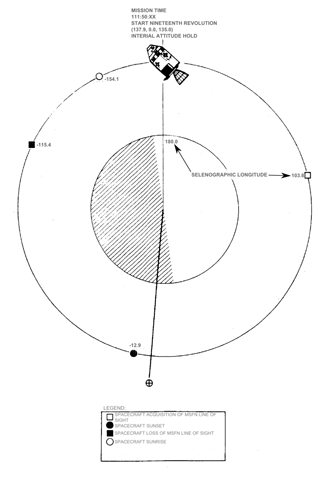
Planned spacecraft attitudes during rev 19.
This is Apollo Control; 112 hours, 14 minutes. We have Acquisition Of Signal from Apollo 10 now. We've been advised that we do have telemetry data from this spacecraft and we don't expect any voice communications from the crew on this revolution. We're now in the 19th revolution of the Moon. And we expect that all three crewmen are sleeping at this time. We only have biomedical data at the present time on Gene Cernan, and that information shows that he is sleeping soundly and has been since 111 hours Ground Elapsed Time. Following the rendezvous and separation maneuver from the Lunar Module, our displays here in Mission Control show that the Apollo 10 spacecraft is now in an orbit with an apogee of 65.4 nautical miles [121.1 km] and a perigee of 56.2 nautical miles [104.1 km]. Our velocity at the present time is reading 5,369 feet per second [1,636 m/s]. And at this time, the spacecraft is at an altitude of 56.3 nautical miles (104.3 km). We'll continue to stand by for the early part of this pass while we get an initial look at the spacecraft systems, and then take the circuit down unless there is some conversation with the crew. Apollo 10 is now approaching the Sea of Fertility on its 19th revolution and telemetry data from the spacecraft shows us that the cabin pressure is maintaining a constant 4.9 pounds per square inch, which is normal. And the cabin temperature at this time is 77 degrees [25°C]. Here in Mission Control, our flight controllers are involved in updating the Flight Plan to reflect the additional 2 to 4 hours of sleep that we expect the crew will be using tonight. And the Flight Plan will be modified to take this into account, in effect moving activities down approximately 4 hours toward the rest period that is scheduled just prior to Trans-Earth Injection. And, with the assumption that the - this brief rest period, which is scheduled almost - more as a short nap prior to TEI, would be shortened to give us some additional sleep time tonight following yesterday's very busy scheduled activities. At 112 hours, 26 minutes; this is Apollo Control.
This is Apollo Control at 113 hours, 30 minutes. We had Loss Of Signal from the spacecraft about 5 or 10 minutes ago. We'll be reacquiring in about 1l minutes. The Flight Dynamics Officer reports that the Lunar Module ascent stage is now 15,161 nautical miles [28,078 km] from the Moon. The vehicle has escaped the Earth-Moon system and is in a solar orbit. We are still getting telemetry information from the vehicle and the estimate is that the electrical lifetime of the stage will extend through 120 hours Ground Elapsed Time. At 113 hours, 32 minutes; this is Apollo Control.
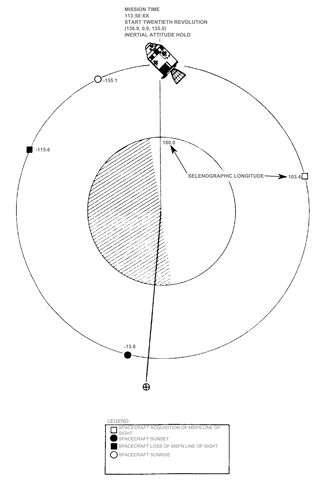
Planned spacecraft attitudes during rev 20.
This is Apollo Control at 114 hours, 12 minutes. Apollo 10 now on its 20th revolution of the Moon. We have Acquisition Of Signal and are receiving data from the spacecraft at this time. The crew has been asleep now for about 3 hours. The sleep period has been extended to 121 hours Ground Elapsed Time due to the fact that the crew was a little longer than anticipated in beginning the sleep period. The spacecraft cabin temperature has been running about 75, 77 degrees [25°C], and cabin pressure holding at 4.9 pounds per square inch. The Lunar Module ascent stage is now about 17.580 miles [32,558 km] from the Moon, and its traveling at a speed of about 5,476 feet per second [1,669 m/s]. We should continue to get telemetry information from the LM for about 6 more hours. Estimate that the battery lifetime of the vehicle will extend at least until 120 hours Ground Elapsed Time. In about 30 more minutes, we'll be having shift handover here in Mission Control. Some of the Orange Team of flight controllers are now coming on duty and they will be getting briefed from the previous team during the next 30 minutes, with handover to come at 6:30 Central Daylight Time. At 114 hours, 15 minutes; this is Apollo Control, Houston.
This is Apollo Control; 115 hours, 25 minutes Ground Elapsed Time. 5 hours, 34 minutes remaining in the Apollo 10 crew sleep period. The Orange Team of flight controllers has settled in for the day here in Mission Control. The ascent stage of Snoopy is out in excess of 20 thousand miles [37,000 km] away from the Moon, going into solar orbit. The spacecraft, as we had Loss Of Signal around the back side of the Moon a few moments ago, on the Command Module was all functioning quite well. The crew apparently sleeping well. And at 115 hours, 26 minutes Ground Elapsed Time; this is Apollo Control.
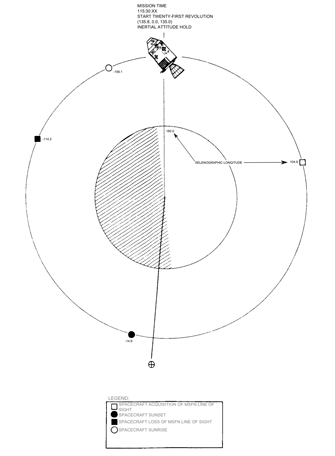
Planned spacecraft attitudes during rev 21.
This is Apollo Control at 116 hours, 10 minutes Ground Elapsed Time. Apollo 10 has just come over the hill on the 21st revolution around the Moon. Orange Team Flight Director Pete Frank is having lengthy discussions with all of the console positions here and sorting out the various status of the - various systems status. We have 4 hours, 48 minutes remaining of the crew rest period, which has been extended about two revolutions so that the crew can rest after a rather busy day yesterday in their rendezvous sequence. We have Loss Of Signal from the spacecraft in another hour and 10 minutes in this rev as it goes around behind the Moon again. We're now showing a measurement of the Command Module orbit around the Moon; an apocynthlon of 66.1 degrees - as you were, nautical miles [122.4 km], 55.7 nautical miles [103.2 km] pericynthion. In slipping the lunar orbit activities two revolutions, or approximately 4 hours, the lighting and landmark appearances and so on will remain essentially the same, as if they had been done on the preflight schedule. It's rather quiet here in the Control Center. Very little noise other than on the communication loops. At 116 hours, 12 minutes Ground Elapsed Time; this is Apollo Control.
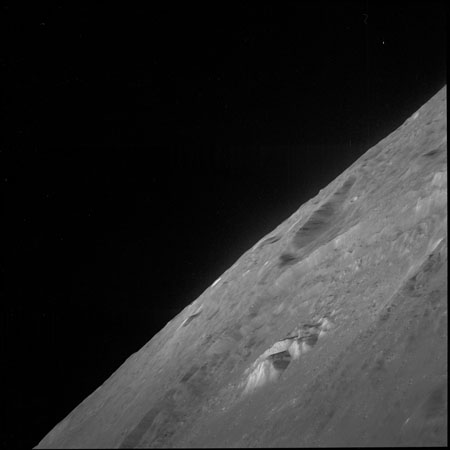
AS10-32-4732 - 80mm, target of opportunity, Theophilus - Image by NASA/JSC/ASU.
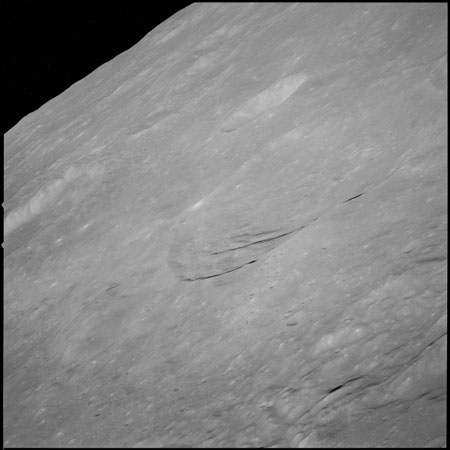
AS10-32-4733 - 80mm, target of opportunity, Delambre and Alfraganus - Image by NASA/JSC/ASU.
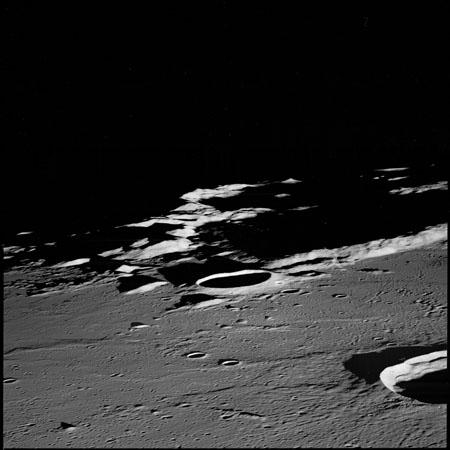
AS10-32-4734 - 80mm, target of opportunity 123, Triesnecker on right and Chladni in centre - Image by NASA/JSC/ASU.
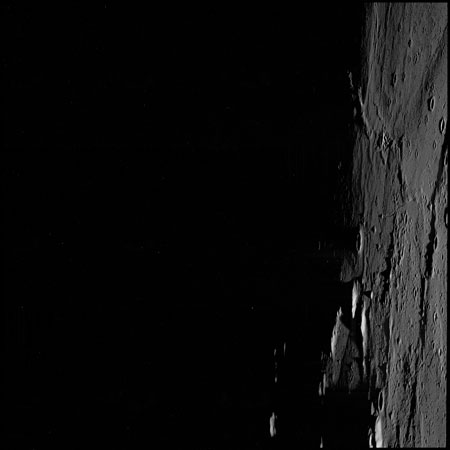
AS10-32-4735 - 80mm, target of opportunity 142, Sinus Medii - Image by NASA/JSC/ASU.
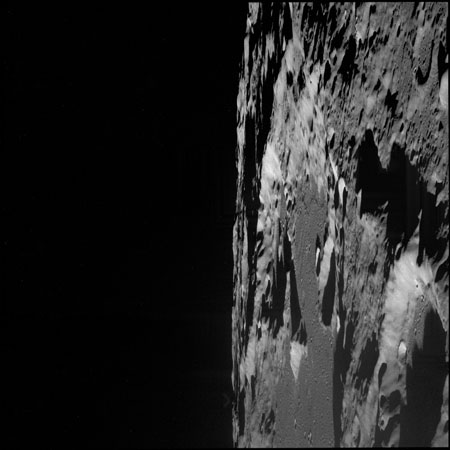
AS10-32-4736 - 80mm, target of opportunity, Halley in foreground, Albategnius in centre - Image by NASA/JSC/ASU.
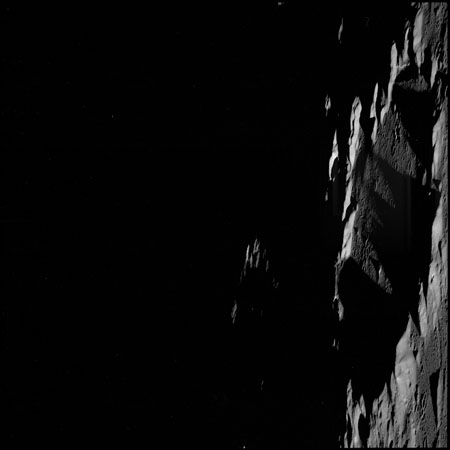
AS10-32-4737 - 80mm, target of opportunity 142, R´aumur - Image by NASA/JSC/ASU.
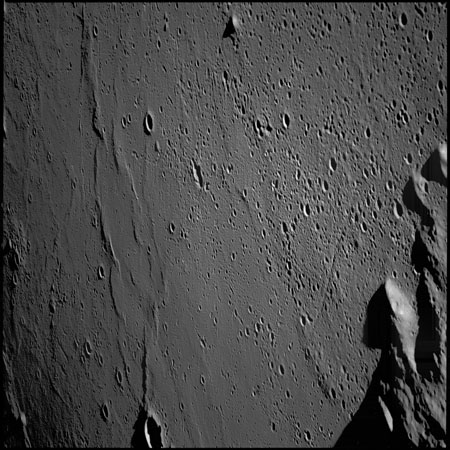
AS10-32-4738 - 80mm, target of opportunity 142, Sinus Medii, Rhaeticus L on right and Blagg on lower edge - Image by NASA/JSC/ASU.
116:32:52 Cernan: Hello, Houston. Houston. This is Apollo 10. Over.
116:32:56 Lousma: Good morning, Apollo 10. This is Houston. Go ahead.
116:33:03 Cernan: Stand by one, Jack.
This is Apollo Control, the crew is now calling back to Earth. Let's listen in.
It's reported on the ground here that the crew is conducting a fuel cell purge and a charge of battery A. They made one brief call to Earth which was responded to by...
116:33:49 Cernan: ...I've got Battery A on the line, and I'm purging the fuel cells at this time. I've gone through O
2 on 3, and I'm down, I'm on 2 now.
116:33:59 Lousma: Roger. We copy.
116:34:24 Cernan: How are things in Houston this morning?
116:34:28 Lousma: Everything's great. Everybody's raving about your performance yesterday and very happy. No doubt you guys are equally well pleased.
116:34:44 Cernan: ... good day, Jack. Pretty challenging and pretty satisfying really, when we look back at it.
116:37:29 Lousma: Apollo 10, this is Houston. You got up kind of early this morning. We were going to let you sleep in for quite a while yet. We've got a little information that will be of interest to you. Your consumables are away ahead of schedule as usual. We have you in a 65.9 by 55.6 orbit [122.0 x 103.0 km]. Your spacecraft looks real good. You might be interested to know that the LM ascent stage is 23,000 miles [42,500 km] from the Moon heading straight up at 5,400 feet per second [1,645 m/s], and haven't quite been able to tell yet whether it's going into orbit around the Sun or if it's going to head straight at the Sun.
116:38:22 Cernan: Hot, isn't he? 23,000 miles [42,500 km] away?
116:38:25 Lousma: Yes. Old Snoop's really moving out.
116:38:32 Cernan: I hope I didn't leave my watch aboard there.
116:38:42 Cernan: You can still track him, can you?
116:38:47 Lousma: We're still tracking him.
116:38:48 Cernan: You can?
116:38:50 Lousma: That's affirmative. We're still tracking him and checking the LGC, and so forth.
116:39:03 Lousma: Matter of fact, we just got an E-Memory dump of him. Oh...
116:39:08 Cernan: You got an E-Memory dump?
116:39:12 Lousma: That's affirmative. Old Snoop, he doesn't give up.
116:39:21 Lousma: I've...
116:39:22 Cernan: Holy smoley!
116:39:24 Lousma: And, 10, this is Houston. I've got a congratulatory message here. It says, "Congratulations on doing what I've been trying to do for a long time." Signed, Red Baron.
116:39:42 Cernan: Beautiful.
116:40:18 Cernan: Houston, I've got a status report for you.
116:40:20 Lousma: Roger. Go ahead.
116:40:26 Cernan: We're all feeling good, and were about ready to [garble]. We got in about 5 to 6 hours pretty fair sleep. The rads: CDR is 26040; the chimps (CMP) is 05309 [garble] and 15041. Cycling the fans at this time [garble] purge.
116:41:15 Lousma: Apollo 10, Houston. You're coming in very broken. We're going to have to repeat the report. Wait one until we check out the network. Over.
116:41:28 Cernan: How do you read me now, Jack?
116:41:31 Lousma: You're cutting out. Let's attempt to fix it up with the network, and then we'll give you a call in a minute.
116:42:12 Lousma: Okay, Apollo 10. This is Houston. We're ready to try it again. Go ahead with your crew status, please.
116:42:20 Cernan: Okay. We got 5 or 6 pretty good hours sleep last night. Tom's fixing chow, John's taking targets of opportunity, and our rad readings are as follows in order: 26040, 05309, and 15041. The purge is complete, and the fans have been cycled.
116:42:52 Lousma: Okay, Gene-o. We copy your 5 to 6 hours, 26040, 05309, 15041. And we'd like you to operate in BD roll today. Over.
116:43:08 Cernan: You'd like us to operate in BD roll today.
116:43:11 Lousma: That's affirmative.
116:47:25 Lousma: Apollo 10, Houston. When you're ready, I have some updates. And we have the morning newspaper.
116:47:39 Cernan: Jack, stand by on that for a minute. We'll all get on a head set.
116:48:06 Cernan: Hey, Jack.
116:48:08 Lousma: Go ahead.
116:48:12 Cernan: Okay. In doing a little troubleshooting on our LM 70mm Hasselblad, it turned out that the batteries are good, but the LM, or the lens - you cannot take the lens off. And what I really anticipated probably is that little docking pin on the lens is jammed. We never did have it off, so it wasn't a case of putting it on wrong. But it appears to be jammed, and I can't get the lens off at all. Do you have an idea that might help us troubleshoot this one?
116:48:44 Lousma: Okay. Understand.
116:48:45 Young: Want me to break out my tool kit, Jack, and take that thing apart!
116:46:50 Lousma: Standby.
116:49:24 Lousma: 10, Houston. We'll get an answer to you on which camera procedure to use. We're working on that now.
116:49:36 Cernan: Hey, Jack. I think that's that it is, though, since I can't take the lens off and the batteries are all good. It appears that it may be jammed.
116:49:46 Lousma: Roger. Thank you.
116:50:28 Cernan: Okay, Jack. Tell the camera experts to forget it. I got it psyched out. I had to spin that gear wheel around until I got the flat side up, and now it appears to work. But it was apparently some sort of self-jamming capability.
116:50:44 Lousma: Roger. We copy. Neatly devised.
116:50:55 Cernan: Hold off. Wait a minute. Let it work for 1 minute, and let me see what happens.
116:54:41 Cernan: Hey, Jack.
116:54:43 Lousma: Go ahead.
116:54:55 Cernan: Okay, here's the story on the camera.
116:55:01 Lousma: Say again, please.
116:55:04 Cernan: There's a gear - Okay. I've got a story on the camera. I need some help, I guess, all right?
116:55:10 Lousma: Roger. Go ahead.
116:55:11 Cernan: So listen for a second. Okay, that gear on the back, the gear on the back when you take the magazine off, this is on the camera base itself. It's got teeth on except for one area where there's a flat spot. If you turn the gear over, push the gear over so that the flat spot is face up, I can do two things. I can snap the picture and/or take the lens off. But as soon as I snap one picture, the gear does not rotate and I cannot take the lens off. The lens does not lock and the camera will not cycle any more after that. Now this occurs both with and without a back on.
116:56:09 Lousma: Okay, Gene. We copy that. And we'll get to work on it.
116:56:18 Cernan: Okay. Thank you, Jack.
116:56:28 Young: Remember, Jack, the right kind of picture might find out how all this started.
116:57:49 Cernan: Houston, this is 10. One little bit of further information on that camera base is the fact that, when I got it cocked for that one shot it'll take, that gear does not rotate, so as to turn the film pack over. It doesn't even rotate without a film pack in it.
116:58:11 Lousma: Okay. we copy that the gear won't rotate with or without a film pack in it after taking a picture. Is that affirmative?
116:58:21 Cernan: Yes. And I can send it through one cycle myself and it's all recocked. And I have to do that with a pencil to wedge that gear around and it's recocked. And then it works fine for one more shot and that's it.
116:58:37 Lousma: Roger. We copy that the gear cycles - has to be cycled manually as opposed to turning automatically after taking a picture.
116:58:54 Cernan: I'll play with it a little while longer and see if there's something screwed up in this lens thing.
116:58:58 Lousma: Roger. We have people working on it.
116:59:45 Cernan: Roger. One final little bit more of information. When I did [garble] recocked that gear took the lens off, rather, and recocked the gear, I get a one-shot affair, and it appears that the mechanism that's jamming is not in the lens, and it's obviously not in the pack, but it's somewhere in the body of the camera.
117:00:06 Lousma: Roger. We copy.
117:00:39 Lousma: Apollo 10, Houston. Could you give us an inventory of which cameras you have working and what ones you're having problems with at this time. Over.
117:00:51 Cernan: Okay. We've got one 70-millimeter camera with all three lenses, LM lens, two CSM lenses, and I guess we've got two sequence cameras working.
117:01:04 Lousma: Roger. One 70-millimeter and two sequence cameras.
This is Apollo Control during the break in communications here; the crew is apparently getting ready for breakfast. We'll come back and review the activities since they woke up. They woke up almost on the preflight time line, however, it had been planned that they would sleep in another 2 revolutions, or approximately 4 hours later than the normal time. A lengthy discussion took place between Spacecraft Communicator Jack Lousma and LM Pilot Eugene Cernan on how to troubleshoot the jammed still camera aboard the spacecraft, the one that was taken aboard the LM for the low altitude lunar photography. Both - or all 3 crewmen got 5 to 6 hours good sleep; the dosimeter readings on all 3 men were read down to the ground. The ground reported that the LM, the Lunar Module ascent stage, was some 23,000 miles [42,600 km] outbound toward the sun, traveling at a rate of 5,400 feet per second [1,645 m/s]. And possibly before Loss Of Signal, some 14 minutes from now, as the spacecraft passes behind the Moon, the morning news will be read up to the crew. We'll continue to monitor air-to-ground through Loss Of Signal on this the 21st revolution around the Moon, for any further conversation between Apollo 10 and the Mission Control.
117:12:21 Lousma: Apollo 10, Houston. We'll be going LOS in about 10 minutes; and I still have Rev 22 update and oblique photography update for you.
117:12:41 Cernan: Okay, Jack. I'll copy it.
117:12:59 Cernan: Go ahead, Jack. I'm ready to copy it.
117:13:03 Lousma: Okay. The map update pad REV 22: 117:22:53, 119:32:46, 118:09:03. Sunrise, 117:36:00; sunset, 118:48:26. Ready for your readback, and a go ahead on your photography update.
117:13:53 Cernan: Okay. 22: LOS, 117:22:53. 150 is 119 [garble] Sunset [garble].
117:14:31 Cernan: Houston, did you get that?
117:14:38 Lousma: Okay, 10. This is Houston. No, you were cut off part way through the readback. Start at 150, please.
117:14:51 Cernan: 119:32:46, 118:09:03, 117:36:00, 118:48:26.
117:15:01 Lousma: Okay. That's affirmative. You ready to go ahead with LS2 photography PAD:
117:15:26 Cernan: Yes. I'm ready to copy something, John - or Jack. Go ahead.
117:15:29 Lousma: Okay. LS2 PAD: f:8 is 118:28:52. T
1 is 118:33:15, with your TCA [Time of Closest Approach] at 2 minutes; f:2.8 is 118:34:15 with your TCA at 1 minute. T
2 is 118:35:15 TCA.
117:16:46 Cernan: Hey. Jack. I got that all down but I'm not sure what you all said. I'm looking for the PAD that it goes to.
117:16:56 Lousma: Okay. It's entitled. "Oblique Photography," and f:8 is camera on [time]. T
1 is start a half a degree...
117:17:07 Cernan: Yes. But what page - hey, is that - Don't we have an update here somewhere? Can you give me the page it's on?
117:17:30 Lousma: Apollo 10, Houston...
117:17:32 Young: Jack, we don't have the same...
117:17:38 Lousma: Roger. On the Flight Plan...
117:17:40 Young: Jack, can you tell them like it is in the...
117:17:44 Lousma: Roger. On the Flight Plan page 3-71 we have an, update for oblique photography. However, that format has been changed and a new format as I have given it to you.
117:17:57 Young: Well, we can't change it. Now you...
117:18:09 Lousma: 10. Houston. We'll get it back in the old format for you. I'll get...
117:18:15 Cernan: Okay. I wish you would. We don't understand the new one.
117:18:18 Lousma: Roger. We'll get it back in the old format and...
117:18:21 Cernan: I've got all the words. Jack.
117:18:24 Lousma: Okay. We'll. get it back in the old format and check with the appropriate people, and in the meantime. I have a correction on your map update PAD. You'll be crossing 150 west at 117:33:36.
117:18:51 Cernan: Yes. I guess that sounds a little bit better. Listen, while you're getting it in that old form, tell me what you told me, because we're going to lose LOS, and maybe we could do something with it here.
117:19:05 Lousma: Roger. We want the camera on f:8 at 118:28:52, and we want you to start your half-degree-per-second pitch rate at 118:33:15. And, we want you to go f:2.8 at 118:34:15. And then you can stop your pitch at 118:35:15.
117:19:50 Cernan: Okay. We'll put the camera on at f:8 at 118:28:52. We start half degree-per-second pitch rate at 118:33:15. We go to f:2.8 at 118:34:15. And then we stop our pitch at 118:35:15.
117:20:10 Lousma: That's affirmative.
117:20:23 Young: Boy, I knew you guys just couldn't resist waiting until we got airborne and then change all the formats. How about that?
117:20:37 Young: That's what we get for missing that data priority meeting you had after lift-off.
117:22:11 Lousma: Okay, Apollo 10. Houston. Before you go out of sight here, some more information on your update for ALS2. Your roll should be 180, your pitch 339, and your yaw 000. and the TCA numbers we were giving you were time-of-closest-approach, so that T
1 would be 2 minutes before closest approach. And you go to f:2.8, 1 minute before closest approach; and then T
2, or course is time-of-closest-approach. Over.
This is Apollo Control. Apparently we have had Loss Of Signal from Apollo 10 as it went over the hill on the 21st revolution. Toward the end of that pass the spacecraft communicator Jack Lousma passed up to the crew some pointing angles and times for some stereo strip photography of landing site 2. The strips will be forward looking as they approach the landing site. The camera will be started when their landing site is first on the lunar horizon, and then the spacecraft will be pitched down to keep the landing site within the camera view until the camera is vertical to landing site 2. Most of today's activities will be photographic tasks, lunar landmark tracking tasks. In the photography task, will be included stereo strips from terminator to terminator. In other words, the shadow of the Moon where the sunlight leaves off; where the sunlight begins all the way to where we have lunar twilight or what is called penumbra. We have 44 minutes, 14 seconds until next acquisition on the 22nd rev; and at 117 hours, 24 minutes Ground Elapsed Time; this is Apollo Control.
117:22:47 Stafford (onboard): [Garble].
117:23:41 Cernan (onboard): You're [garble].
117:24:16 Cernan (onboard): [Garble] we go ahead?
117:24:18 Young (onboard): I don't know. [Garble].
117:24:58 Young (onboard): Okay. [Garble].
117:25:07 Cernan (onboard): [Garble].
117:26:09 Young (onboard): [Garble] real good? Okay?
117:26:14 Cernan (onboard): [Garble].
117:26:15 Young (onboard): Yes, I think so. [Garble].
117:26:33 Young (onboard): Yes. Those guys [garble].
117:26:41 Cernan (onboard): [Garble] after TEI, we're all sitting on our...
117:26:43 Stafford (onboard): [Garble]?
117:26:15 Young (onboard): Yes. There is still a lot of [garble] all my work [garble] fighting those freaking hoses. [Garble] those goddam things.
117:27:02 Young (onboard): Man, I was running all over the cotton-picking [garble] every time [garble].
117:27:09 Cernan (onboard): You know, it's really - [garble]. It just flows right out here. I - I [garble] get over there and back [garble].
117:27:36 Young (onboard): Hell, yes; I tried [garble].
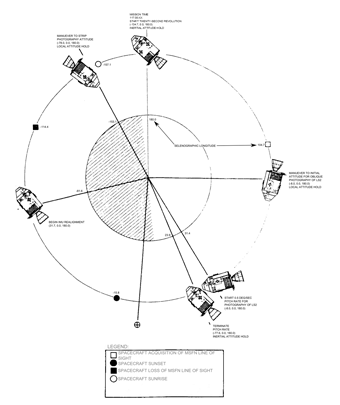
Planned spacecraft attitudes during rev 22.
117:31:55 Stafford (onboard): [Garble].
117:32:37 Young (onboard): [Garble] here.
117:32:40 Stafford (onboard): All I can see is Mars and Antares.
117:33:01 Stafford (onboard): Get the [garble].
117:33:40 Stafford (onboard): [Garble].
117:33:59 Stafford (onboard): Don't we need three?
117:34:19 Stafford (onboard): That puts you at 118, and you've got 30 minutes [garble].
117:34:27 Stafford (onboard): [Garble] Automaneuver, John? Well now, what - what's the inertial angle now?
117:34:48 Stafford (onboard): I think so, if this thing works. Say, how was - somebody's got to [garble]. How are we going to do it [garble]?
117:35:00 Stafford (onboard): Yes.
117:35:08 Stafford (onboard): I don't know. Let me get the card. [Garble] that way.
117:35:20 Stafford (onboard): [Garble].
117:35:39 Stafford (onboard): [Coughing] [Garble] pressurize it through here. Try to get a hold right here [garble]. How's that? [Garble] straight?
117:36:57 Stafford (onboard): Yes. [Garble].
117:37:38 Stafford (onboard): Yes. I - I - Yes, that'll be right, John.
117:37:55 Stafford (onboard): Have you still got the [garble]? [Garble].
117:38:30 Stafford (onboard): This is [garble]. Well, I got about 30 or 40 pictures [garble], John. [Garble].
117:38:36 Cernan (onboard): We're using the black and white film [garble].
117:39:01 Stafford (onboard): What's the [garble] - the whole roll?
117:39:06 Cernan (onboard): [Garble].
117:40:32 Stafford (onboard): John, I've got - I've got some [garble] here to put all that crap [garble].
117:41:06 Stafford (onboard): Do it in color or black and white?
117:41:13 Stafford (onboard): John, how - Oh, yes, you can. Hey, I'll tell you one thing we might do. Yes, we can just clean out this stuff in the inflow valve. Yes. Oh, that son of a bitch is [garble] there. Yes.
117:41:32 Young (onboard): Need some tape?
117:41:35 Stafford (onboard): Gene-o, where's the tape?
117:41:53 Stafford (onboard): [Garble] is still holding [garble].
117:43:22 Stafford (onboard): Yes, babe. Where was that little plastic bag? Oh,
there it is, right there, behind, you, John.
117:43:31 Young (onboard): [Garble].
117:43:32 Stafford (onboard): Right there on the [garble]. That's the one.
117:44:20 Stafford (onboard): [Garble].
117:45:16 Stafford (onboard): What time are you supposed to start pitching? Matter of a fact, I'd better get over there. No, I'm doing it.
117:45:28 Young (onboard): Okay.
117:45:36 Stafford (onboard): Yes, that's [garble], babe. They want - they want roll 180 and pitch to 231, huh?
117:47:25 Stafford (onboard): Hey, Gene-o. While you're down there, would you put this, you know, this ... bag back, babe? No, it's not. It's in that - [garble] bag [garble].
117:48:23 Stafford (onboard): This is just a [garble] of the last time [garble]. Yes.
117:49:27 Stafford (onboard): Yes. [Garble]. Yes, [garble].
117:50:43 Stafford (onboard): [Garble].
117:50:50 Stafford (onboard): Hold it.
117:51:46 Stafford (onboard): [Garble].
117:52:20 Stafford (onboard): [Garble]. Huh? Two dots? Yes.
117:52:45 Stafford (onboard): Look at that son of a bitch! No, look at this. Look at this! Look what I found - out the window. What do you see, old buddy? [Garble] appear in a magnetic field. Look out there. We got a piece of Snoopy hanging on. It's - it's [garble]. Get a picture of that. Black and white [garble] color.
117:53:08 Stafford (onboard): Here. You got some. color?
117:53:20 Stafford (onboard): Yes. You still have - f:11 at 250. A piece of Snoop [garble] you get it, John. Just hanging there. 17 - 53.
117:54:09 Stafford (onboard): That's got to be Snoopy.
117:54:22 Stafford (onboard): Huh? It is?
117:54:34 Stafford (onboard): It's yellow like that, huh?
117:54:58 Stafford (onboard): You got the color squared away? ... you want to take - Oh, you - oh, you - did this - this what I'd been using yesterday.
117:55:19 Cernan (onboard): Yes, it's out.
117:55:20 Stafford (onboard): [Garble] there's another [garble] color film. That stuff [garble] color film.
117:55:39 Stafford (onboard): I don't have it here. Yes, I do, too. Here we go. Take this. We ought to get a lot of [garble]. Here we are. Here is your color film. Right.
117:56:56 Stafford (onboard): This is a good film [garble]. You - didn't get it, huh?
117:57:23 Stafford (onboard): That's when I called in some stuff the other day, y'all [garble]. Okay, Gene-o, [garble] pitch up.
117:57:41 Stafford (onboard): Hey, Gene-o, while you're down there, how about opening this thing; put the rest of these things down there. [Garble].
118:00:04 Stafford (onboard): Okay, we're still upright at 335 Orb Rate.
118:00:26 Stafford (onboard): How about killing one of these roll [garble], babe?
118:01:20 Stafford (onboard): Okay, base it. 16 millimeter. Oh, you're not going to use real phase, are you? 8 - f:8 at [garble].
118:01:50 Stafford (onboard): Do you want the color, babe? This is used. We're all out of color on this.
118:02:25 Stafford (onboard): Here's one over here, Gene-o. See that black? Black is [garble]. Can you see over to the left here or do you want me to take it? Hold it, Gene-o. How much - how much of the stuff we got left? About out?
118:03:13 Stafford (onboard): [Garble].
118:05:14 Stafford (onboard): [Garble]. Got this all started, babe.
118:05:52 Stafford (onboard): Well, we could [garble] that [garble].
118:05:58 Cernan (onboard): What? Yes.
118:06:06 Stafford (onboard): That son of a bitch right down below us is tan and brown. I don't - it - Look at those [garble] craters. You got some coming straight down below you, Gene-o.
118:06:37 Stafford (onboard): Hey, here's a good example of what fills up craters. You see that son of a bitch coming in down below. You - Get a look at its [garble] in there. I mean. Beautiful. Okay.
118:06:54 Stafford (onboard): Hey, you see this big, big one down here right be to your left, John, probably. We're coming around - You see how the sides are slumping down and filling up the bottom? That might not be any [garble].
118:07:33 Stafford (onboard): It looks like that stuff is scraped off. It's in big layers, and it's brown, and the whole thing slumped in. [Garble], you know it?
118:09:04 Stafford (onboard): [Garble] oblique thing, what are we using - Did they tell us to use a 250 or an 80 [mm lens]?
118:09:18 Young (onboard): Man, it is - Here's the flattest crater over here.
118:09:24 Stafford (onboard): Oblique [garble].
118:09:44 Stafford (onboard): Yes, babe. Use the 80 and the intervalometer. Where's our intervalometer? José, why don't you get the intervalometer? Also, we need that - we need that mount. [Garble] need the mount [garble]. You know it's...
This is Apollo Control; 118 hours, 08 minutes Ground Elapsed Time. Less than a minute away now from Acquisition Of Signal as Apollo 10 comes around to the front side of the Moon on lunar revolution number 22. During this pass the crew is scheduled to do the stereo strip photography across Landing Site number 2, at which Apollo 11 likely will land. Also as the communications commence in this rev, the crew will be [giving] a consumable update. Standing by for communications to resume. A few minor changes in the Flight Plan will be read up to the crew. However it appears now that they woke up and called Houston about on the normal Flight Plan time, and the Flight Plan is now back on the time line. We likely will have colored television beamed to the Madrid station where it will be recorded during this pass, and perhaps a subsequent pass, and it would be released in the United States on a delayed basis as soon as the video tape could be flown here. However, it would go out in real time to the European television stations. Standing by for the first call. We've got 1 hour and 11 minutes until Loss Of Signal on this 22nd rev. It'll be 119:21 when the Apollo 10 goes over the hill. Also during the updating from the ground to the crew of Apollo 10 will be what's called a TEI-23 PAD, which would simply mean numbers for Trans-Earth Injection burn, should it become necessary at the end of the next revolution, number 23 - this is strictly sort of a backup bit of information.
118:11:34 Lousma: Apollo 10, Houston. How do you read. Over.
118:12:16 Stafford: Hello, Houston. Apollo 10.
118:12:19 Lousma: Roger, Apollo 10. Read you loud and clear. How me?
118:12:24 Stafford: Roger, Jack. We're all set up and we're getting ready to take obliques of the Landing Site 2. Over.
118:12:33 Lousma: Roger, Tom. When you've got time, we've got lots of information for you here.
118:12:44 Stafford: Roger. Just to reconfirm, for the obliques on Landing Site 2, they want the 80-mm lens using the intervalometer. Over.
118:12:52 Lousma: Stand by. We'll get an answer.
118:12:56 Stafford: Okay.
118:13:53 Lousma: Okay, Apollo 10. Houston. We confirm. We want the 80-mm lens in intervalometer on obliques for Site 2. Over.
118:14:45 Lousma: Apollo 10, Houston. Did you copy? We want the 80-mm lens with the intervalometer.
118:15:05 Cernan: Houston, we're down to one sequence camera, because we don't have a power cable for the camera we brought back from the LM.
118:15:15 Lousma: Roger. We copy, John.
118:16:25 Cernan: Jack, did you read us?
118:16:27 Lousma: That's affirmative. We copied.
118:16:46 Lousma: Gene, one sequence camera and one power cable ought to do the job.
118:16:53 Cernan: Jack, we just want to confirm, we use a black and white on this oblique photography. Do you want f:8 or f:4 at 1/250, and then down to f:2.8?
118:17:53 Lousma: Apollo 10, Houston. Use f:4 for the black and white film.
118:20:12 Lousma: Apollo 10, Houston. On your camera settings we read up, at 1/250 go to f:4, and, you will get better pictures later on if, at 118:34, you go down to f:2.8. Over.
118:21:45 Young: Houston, Apollo 10. Over.
118:21:47 Lousma: Go ahead, 10.
118:21:52 Young: Roger. Is Jack Schmitt around anywhere today?
118:21:55 Lousma: Yes. He's here today. Did you copy our last about the f-stops and the speeds and so forth?
118:22:04 Young: Roger. f:4? Right.?
This is Apollo Control. Apollo 10 crew at this time is apparently quite busy, getting lined up for the stereo strip photography of Landing Site 2. It has been rather quiet here as they approach that position. They are now at about 50 degrees east longitude, coming up on Landing Site 2 in the next several minutes. They should be directly over the site at 118 hours, 35 minutes, which is about 10 minutes from now. We will continue to monitor the air-to-ground circuit as conversation does come from Apollo 10. Getting the camera set up with the proper setting on the exposure, proper film magazine, using an intervalometer, which is a device that automatically triggers the camera at a given spacing of pictures while they tilt the spacecraft down to keep the landing site centered in the viewfinder. Continuing to monitor air to ground here for resumption of conversation.
118:26:25 Lousma: Apollo 10, Houston. We have the final change, change 12, on the camera setting. On the 80-millimeter camera...
118:26:37 Stafford: Roger, Go on change 12.
118:26:38 Lousma: On the 80-millimeter camera, should be set at 1/250. And at 28:52, it should be set at f:8 when you turn them on. At 34:15...
118:26:55 Stafford: 1/250 at f:8.
118:26:57 Lousma: That's affirmative. Then at 34:15, you will get better pictures if you will stop to f:2.8 and stop on the time read up to you. Then, one other item of information: actually, we would like you to perform this. We would like you to put both H
2 Cryo tank heaters to Auto. Over.
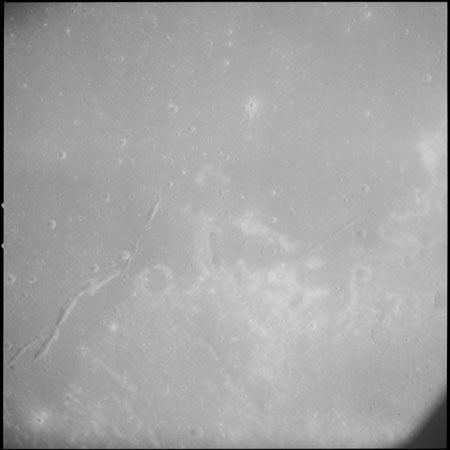
AS10-32-4739 - 80mm, target of opportunity, Rimae Secchi (aka Apollo Rille) & Apollo Ridge - Image by NASA/JSC/ASU.
118:27:24 Stafford: Okay. Both H
2 are on Auto now. Okay. So we will have f:8 at 1/25 at 118:28:52, ½ degree per second at 118:33:15, and then we will go to f:2.8 at 1/25 at 118:34:15.
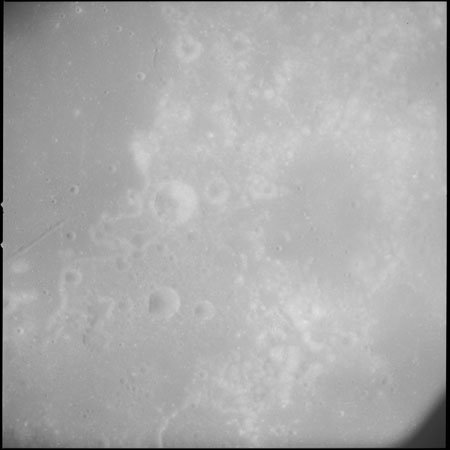
AS10-32-4740 - 80mm, target of opportunity 78a, Seechi U & UA, Lubbock S (aka Smokey Basin) - Image by NASA/JSC/ASU.
118:27:46 Lousma: That's all correct, Tom, except for the time. It would be 1/250; 1 over 250. Over.
118:27:57 Stafford: Oh, it's 1 over 250. Okay. We go to f:2.8 at 12 1/250?
118:28:07 Lousma: That's affirmative. All of your times should be 1...
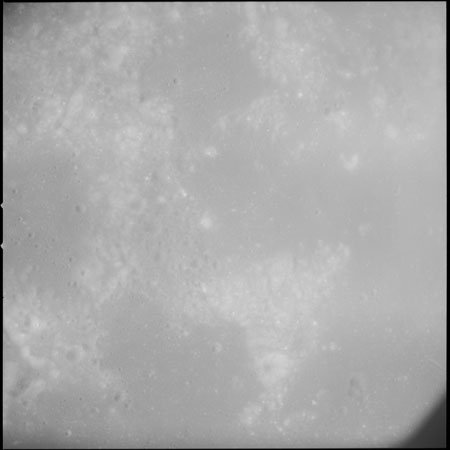
AS10-32-4741 - 80mm, target of opportunity 78a, Lubbock S (aka Smokey Basin) and Mount Marilyn - Image by NASA/JSC/ASU.
118:28:09 Stafford: Okay, Jack. Let's go over this again, doggone.
118:28:13 Lousma: Okay, Tom. At 28:52, you turn your camera on. Your 80-millimeter setting should be 1 over 250 and f:8. Start your pitch rate at 33:15 and stop down to f:2.8 at 34:15. But your time will still be 1 over 250. And then stop your pitch on T
2, as indicated.
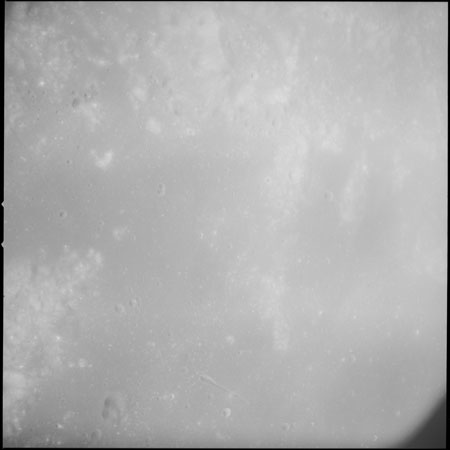
AS10-32-4742 - 80mm, target of opportunity 78a, Chama Peak, Weatherford crater (lower left) and The Cape (right center) - Image by NASA/JSC/ASU.
118:28:41 Stafford: Let's go...
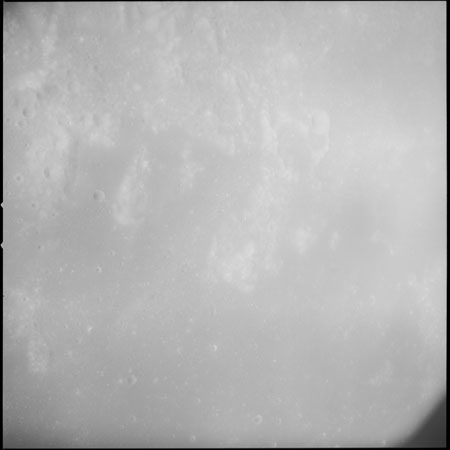
AS10-32-4743 - 80mm, target of opportunity 78a, The Cape, Lubbock M (top left corner) and Cape Venus - Image by NASA/JSC/ASU.
118:30:42 Cernan: Houston, Apollo 10. Over.
118:30:46 Lousma: Go ahead, 10.
118:30:51 Cernan: Where do these changes to these film settings, come from?
118:31:14 Lousma: Apollo 10, Houston. We believe that this information was made clear. It's coming from the camera people, and it's information that we set up initially. Over.
118:31:38 Stafford: Okay. We'll talk about it after we get back on the ground.
118:31:44 Lousma: Roger, 10.
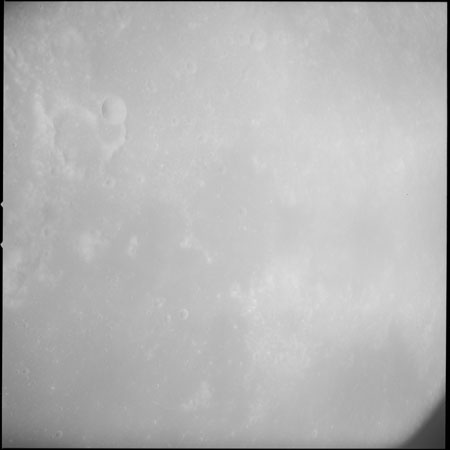
AS10-32-4744 - 80mm, showing an oblique view of the approach to LS2. Censorinus T - Image by NASA/JSC/ASU.
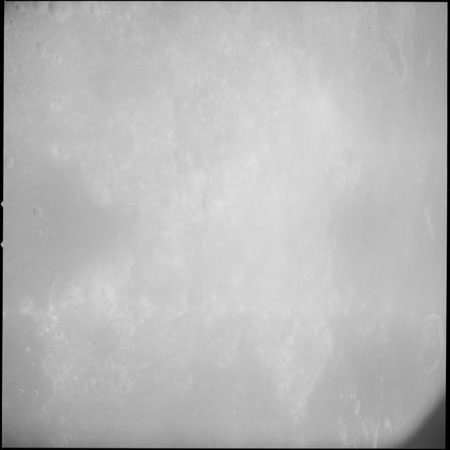
AS10-32-4745 - 80mm, showing an oblique view of the approach to LS2. Censorinus - Image by NASA/JSC/ASU.
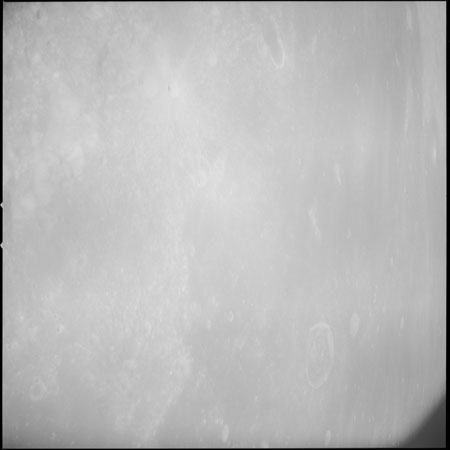
AS10-32-4746 - 80mm, showing an oblique view of the approach to LS2. Censorinus & Maskelyne - Image by NASA/JSC/ASU.
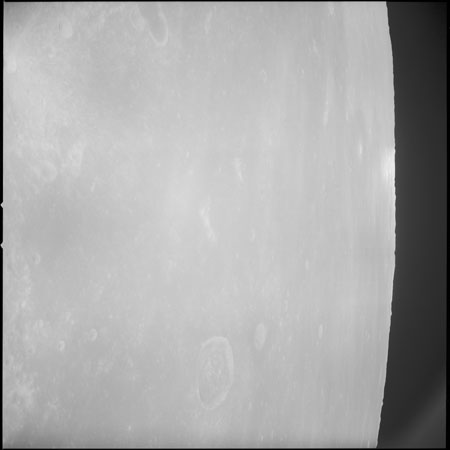
AS10-32-4747 - 80mm, showing an oblique view of the approach to LS2. Maskelyne - Image by NASA/JSC/ASU.
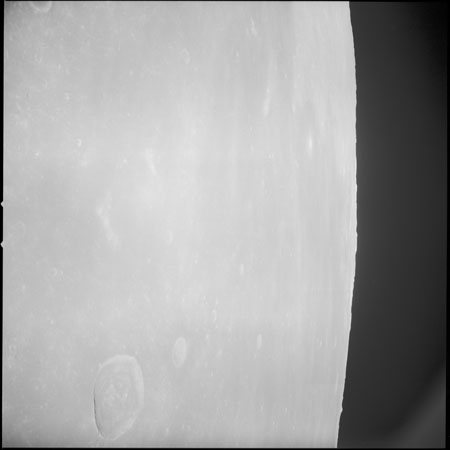
AS10-32-4748 - 80mm, showing an oblique view of the approach to LS2. Maskelyne and Boot Hill - Image by NASA/JSC/ASU.
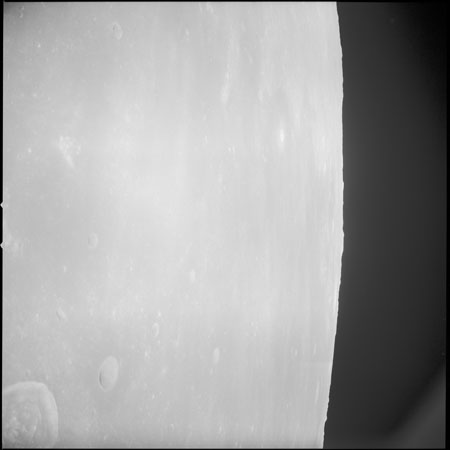
AS10-32-4749 - 80mm, showing an oblique view of the approach to LS2. Maskelyne B - Image by NASA/JSC/ASU.
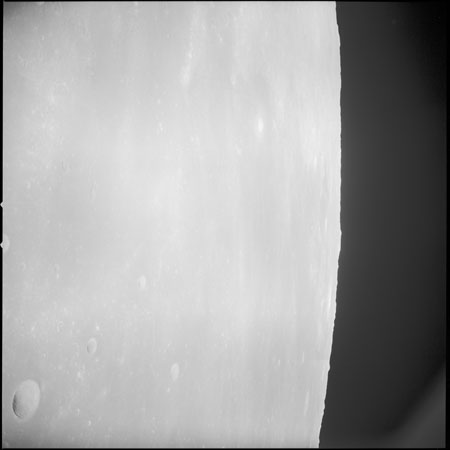
AS10-32-4750 - 80mm, showing an oblique view of the approach to LS2. Maskelyne B - Image by NASA/JSC/ASU.
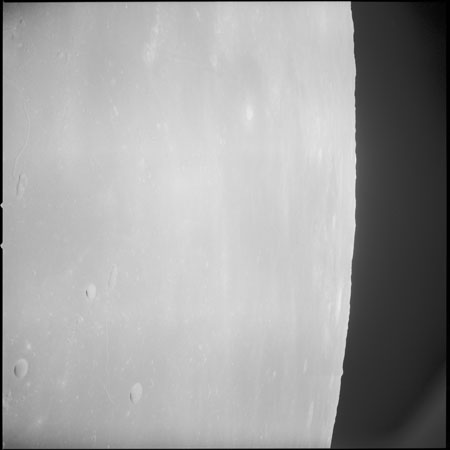
AS10-32-4751 - 80mm, showing an oblique view of the approach to LS2. Sidewinder and Diamondback Rilles - Image by NASA/JSC/ASU.
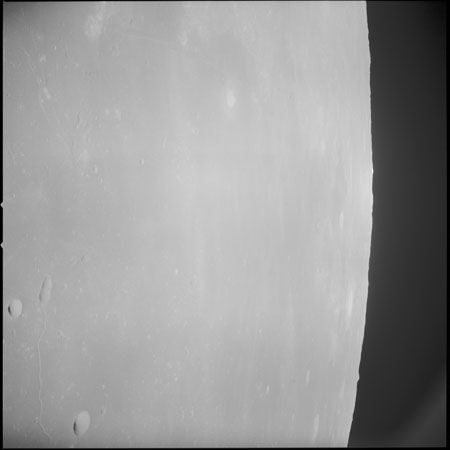
AS10-32-4752 - 80mm, showing an oblique view of the approach to LS2. Moltke & Rima Hypatia - Image by NASA/JSC/ASU.
118:33:10 Stafford: Houston, Apollo 10. I'm looking straight down at Sidewinder Rille.
118:33:15 Lousma: Roger, 10.
118:33:35 Young: Houston, this is Apollo 10. The reason I asked that question is I just shot up a bunch of film on the backside at f:4 at 1/250 in black and white.
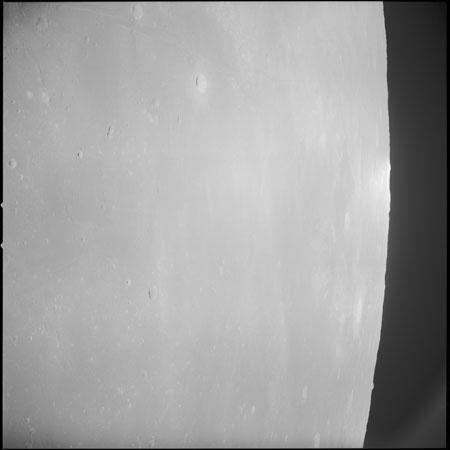
AS10-32-4753 - 80mm, showing an oblique view of the approach to LS2. Moltke - Image by NASA/JSC/ASU.
118:33:48 Lousma: Roger. Those were the standard settings, but the settings we're giving you now are the best ones for oblique photography. Over.
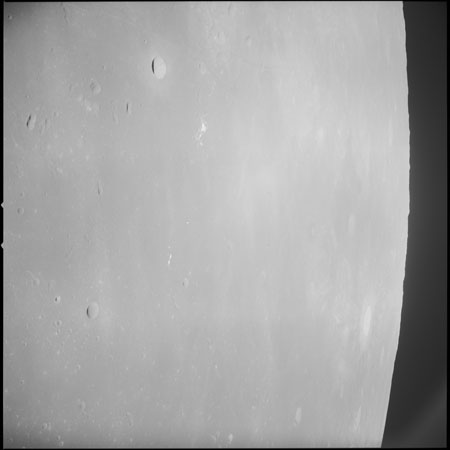
AS10-32-4754 - 80mm, showing an oblique view of the approach to LS2. Moltke and landing site - Image by NASA/JSC/ASU.
118:34:01 Young: Okay. Thank you.
118:34:15 Lousma: In other words, 10, the settings we're giving you now are better than the standard settings, but f:4 is standard.
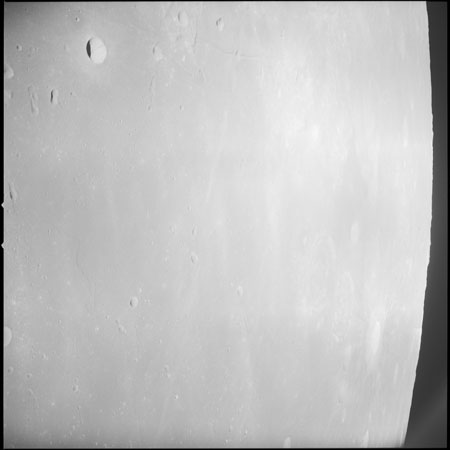
AS10-32-4755 - 80mm, showing an oblique view of the approach to LS2. Moltke and landing site - Image by NASA/JSC/ASU.
118:34:26 Young: Okay, Jack. Peace.
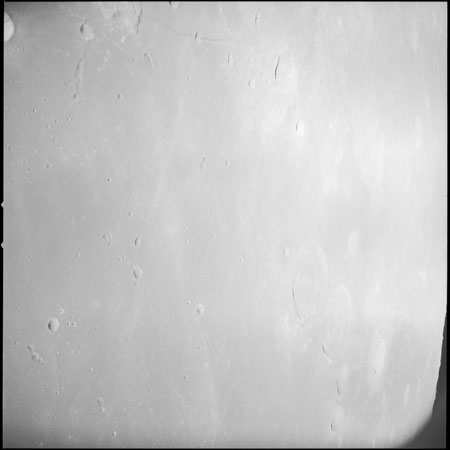
AS10-32-4756 - 80mm, showing an oblique view of the approach to LS2. Approaching Sabine and Ritter - Image by NASA/JSC/ASU.
118:34:54 Stafford: And for Jack's...
118:34:57 Lousma: Say again, Tom.
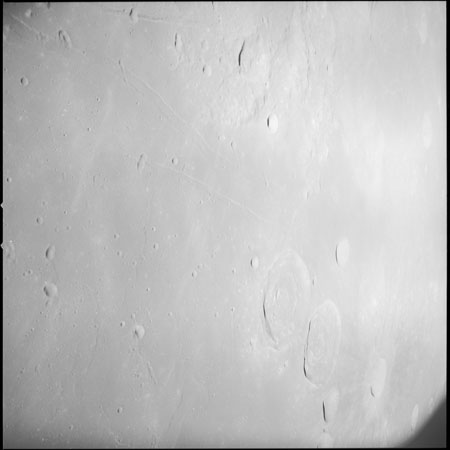
AS10-32-4757 - 80mm, showing an oblique view of the approach to LS2. Approaching Sabine and Ritter - Image by NASA/JSC/ASU.
118:35:23 Lousma: Apollo 10, Houston. If you're transmitting, you're coming in broken. Over.
118:35:30 Stafford: Okay. We're coming right to the landing site now.
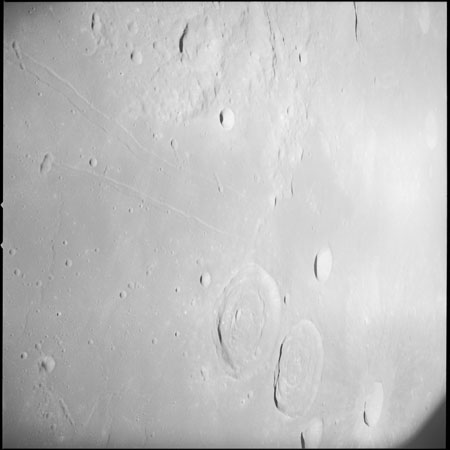
AS10-32-4758 - 80mm, showing an oblique view of the approach to LS2. Approaching Sabine and Ritter - Image by NASA/JSC/ASU.
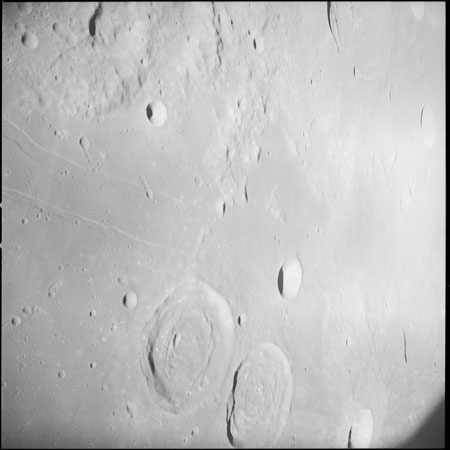
AS10-32-4759 - 80mm, showing an oblique view of the approach to LS2. Approaching Sabine, Ritter and Schmidt - Image by NASA/JSC/ASU.
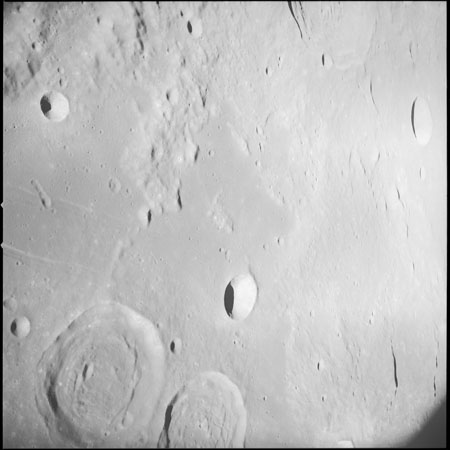
AS10-32-4760 - 80mm, showing an oblique view of the approach to LS2. Approaching Sabine, Ritter and Schmidt - Image by NASA/JSC/ASU.
118:36:18 Young: Tell Jack Schmitt there's some very interesting looking type impacts here on the backside and also some very interesting looking things that sort of look like volcanoes. There's one on the backside that I - that, if it was in a different setting, you would call Mount Fujiyama.
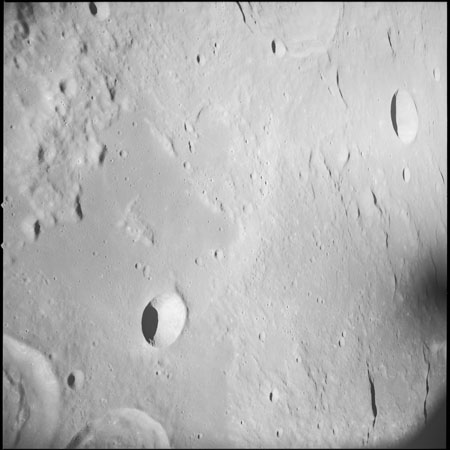
AS10-32-4761 - 80mm, showing an oblique view of the approach to LS2. Approaching Schmidt - Image by NASA/JSC/ASU.
118:36:38 Lousma: Ah so, gazaimaus. [probably 'Ohayou gozaimasu', a Japanese form of 'thank you'.]
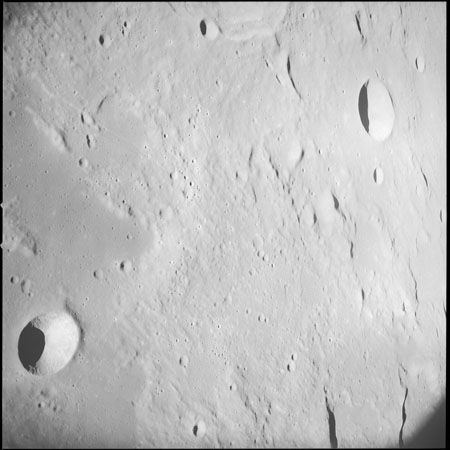
AS10-32-4762 - 80mm, showing an oblique view of Schmidt and Theon Senior - Image by NASA/JSC/ASU.
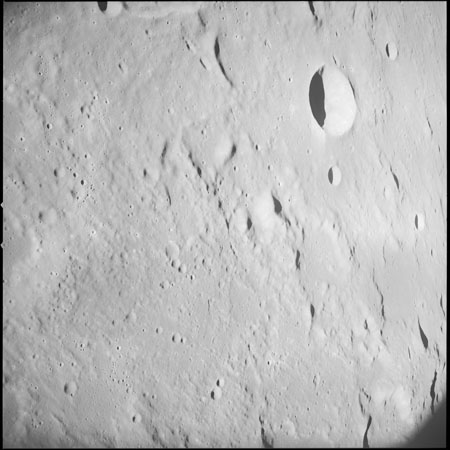
AS10-32-4763 - 80mm, showing an oblique view of Theon Senior - Image by NASA/JSC/ASU.
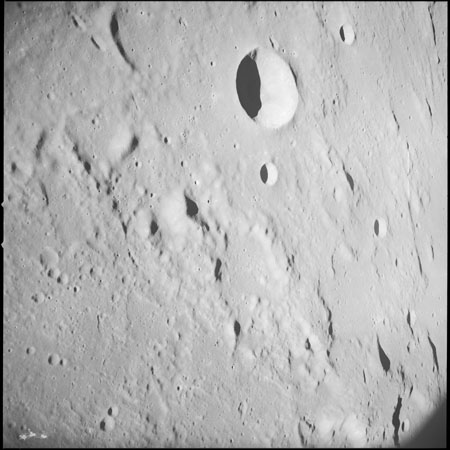
AS10-32-4764 - 80mm, showing an oblique view of Theon Senior - Image by NASA/JSC/ASU.
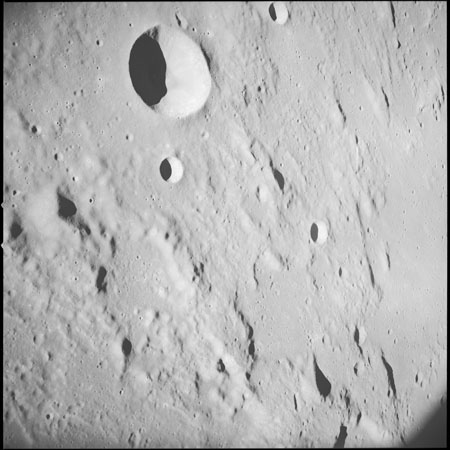
AS10-32-4765 - 80mm, showing an oblique view of Theon Senior - Image by NASA/JSC/ASU.
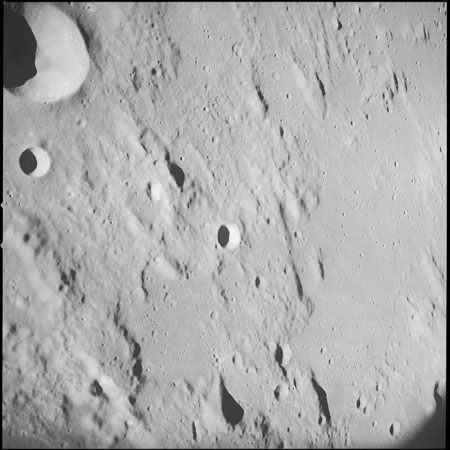
AS10-32-4766 - 80mm, showing an oblique view of Theon Senior - Image by NASA/JSC/ASU.
118:40:54 Stafford: ...Apollo 10. I'm looking backwards [garble] past [garble] Sabine and Ritter [garble] couple of minutes [garble] looking down now [garble] area [garble] over here [garble] all types of volcanic [garble] domes and [garble] uprisings, out here [garble] looks like you've had tremendous volcanic action, here.
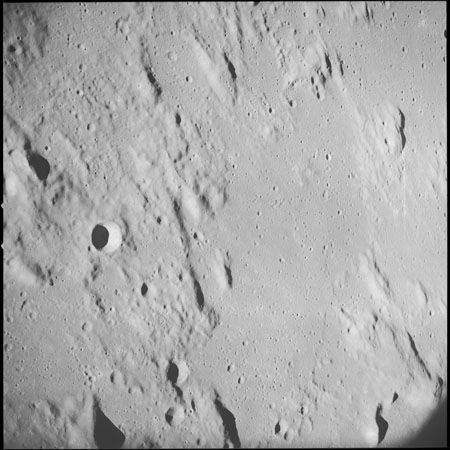
AS10-32-4767 - 80mm, showing an oblique view of Lade A - Image by NASA/JSC/ASU.
118:41:17 Lousma: Roger, 10. We copy. You're coming in a little bit broken, though.
118:41:23 Young: Roger, Houston, Apollo 10. Over.
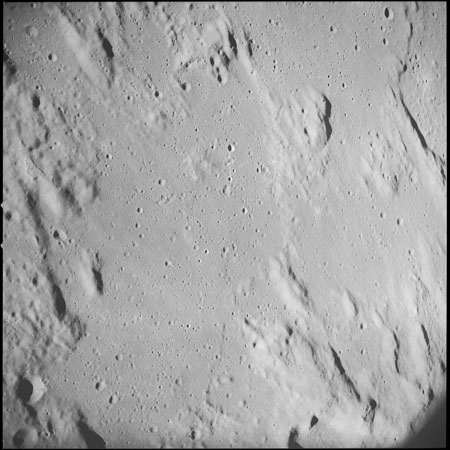
AS10-32-4768 - 80mm, showing an oblique view of Lade A - Image by NASA/JSC/ASU.
118:41:24 Lousma: Okay. You sound better, John.
118:41:31 Young: Okay. This morning when we were turning around, first time, we had about - I estimate maybe a foot-and-a-half, a foot-and-a-half or more of Mylar with that insulation coater on the back of it. It would appear out in front of our window, and I guess it was from the top hatch which is where that insulation came from in the first place. It just sort of sat there for a while and then quietly floated off. But my question is, will this cause us any thermal problems? And my answer is, I guess probably not.
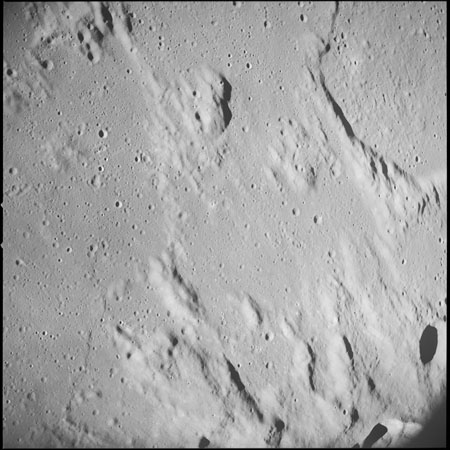
AS10-32-4769 - 80mm, showing an vertical view of Lade A - Image by NASA/JSC/ASU.
118:42:10 Lousma: John, Houston. We didn't copy the first part of your transmission. You were broken. We'd like you to say again your observation. And we'd also like to get some information as to whether or not you are noticing any moisture collecting around that hatch. Over.
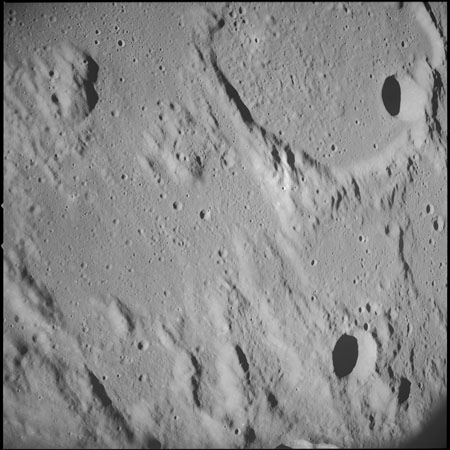
AS10-32-4770 - 80mm, showing an vertical view of Lade - Image by NASA/JSC/ASU.
118:42:32 Stafford: John's going up to take a look at it now.
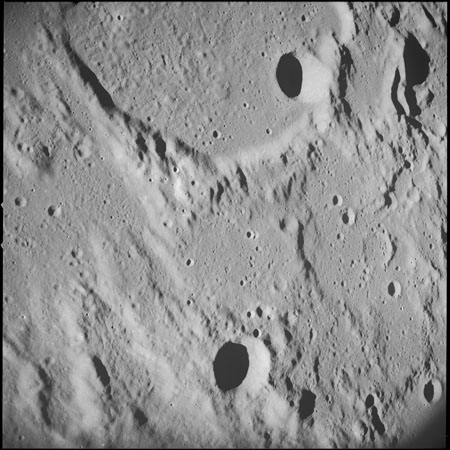
AS10-32-4771 - 80mm, showing vertical view of Lade and Godin - Image by NASA/JSC/ASU.
118:42:35 Lousma: Roger. We have some questions we'd like to ask you regarding that, that you might be able to help us out with while John's up there doing that. And we'd like you to go over again the description of the forward hatch thermal blanket damage. Describe your recollection of the location, the directions, and the general appearance of the edges of the tears. And the reason we want this is because we're CCB-ing it today on 107 and we need the information.
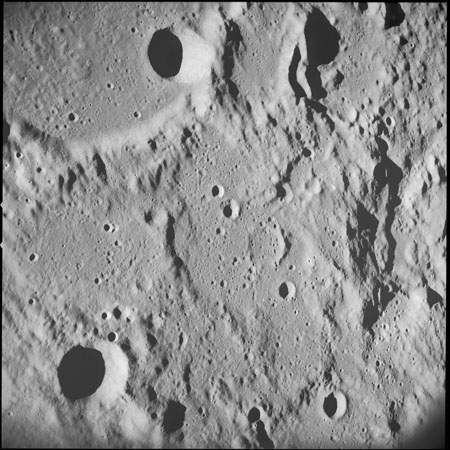
AS10-32-4772 - 80mm, showing an vertical view of Lade and Godin - Image by NASA/JSC/ASU.
118:43:09 Young: Okay, What the problem was, when we opened the pressure equalization valve, it just blew the insulation blanket right up. And I don't know how much air was going in there, and we didn't open it any more than cautiously on that first time, I'll tell you that. And so it wasn't being opened very fast, and what it did was it blew the blanket right up and from then on it blew all the insulation out from down in the Mylar covering, right in the center of the hatch, right in the pressure equalization valve, right around that area. So it seems to be a problem in attaching [garble] around that location. Realize that it's got to put up with the air that comes out of the pressure equalization valve, which could be a pretty considerable force, if you haven't thought about that before. I can see how it happened easy enough.
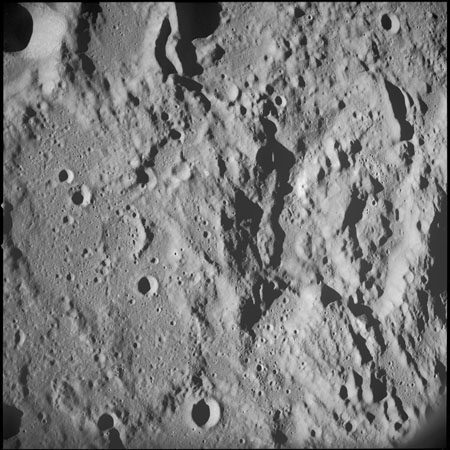
AS10-32-4773 - 80mm, showing an vertical view of Lade S and Rhaeticus F - Image by NASA/JSC/ASU.
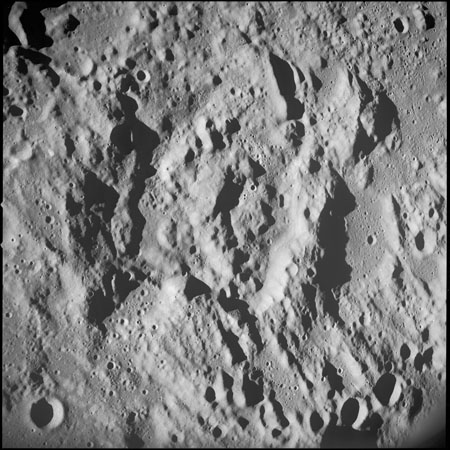
AS10-32-4774 - 80mm, showing an vertical view of Rhaeticus F - Image by NASA/JSC/ASU.
118:44:17 Stafford: Houston, Apollo 10. Just inside the Command Module we picked up the bag that you stow your gloves in inside the helmet. We have one of those bags that we jettisoned in Snoopy completely full of this fiberglass Mylar.
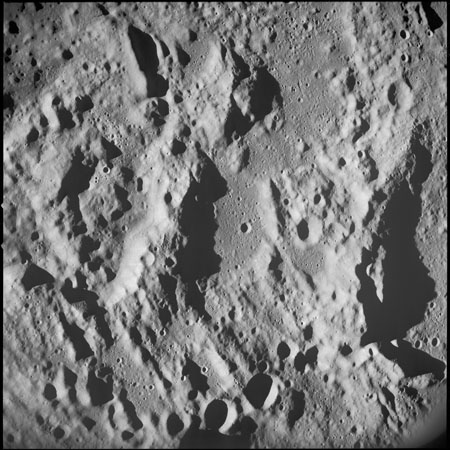
AS10-32-4775 - 80mm, showing an vertical view of Rhaeticus F - Image by NASA/JSC/ASU.
118:44:35 Lousma: Roger, 10. Understand that when you opened the pressure equalization valve, the insulation blanket blew up and then blew out insulation from around the pressure equalization valve and you filled a whole bag of it. Is that affirmative?
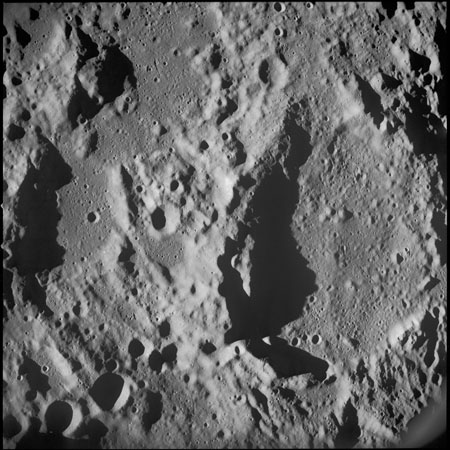
AS10-32-4776 - 80mm, showing an vertical view of Rhaeticus - Image by NASA/JSC/ASU.
118:44:57 Stafford: That is affirmative. And we still have - still finding considerable pieces of insulation in the Command Module, and Snoopy looked like a snowstorm hit it inside there. Needless to say, it makes you itch quite a bit in the eyes, ears, nose, all over; but there's no problem to continue.
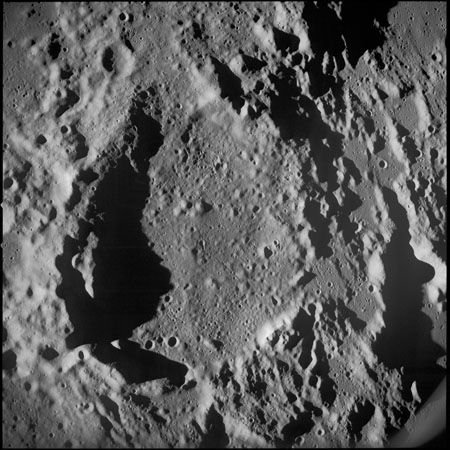
AS10-32-4777 - 80mm, showing an vertical view of Rhaeticus - Image by NASA/JSC/ASU.
118:45:17 Young: Of course we didn't realize we had it until we pulled the hatch off in there, and first we knew was when we got the hatch turned over, boy that was...
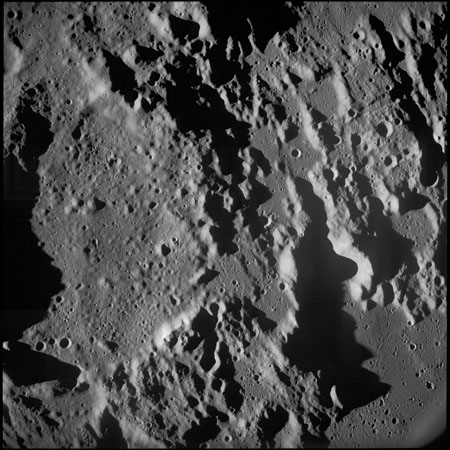
AS10-32-4778 - 80mm, showing an vertical view of Rhaeticus - Image by NASA/JSC/ASU.
118:45:25 Stafford: Looked like [garble] snowstorm [garble] got all the insulation...
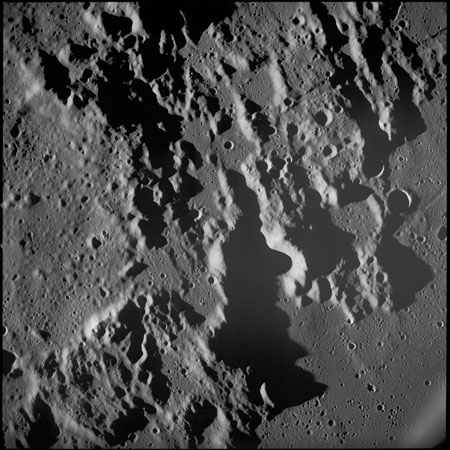
AS10-32-4779 - 80mm, showing an vertical view of Rhaeticus & Rhaeticus L - Image by NASA/JSC/ASU.
118:45:35 Lousma: Apollo 10, this is Houston. You're getting unreadable. We're going to have to clear up this comm before we go on. Over.
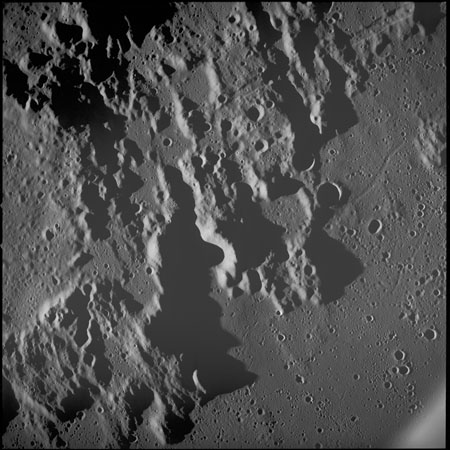
AS10-32-4780 - 80mm, showing an vertical view of Rhaeticus & Rhaeticus L - Image by NASA/JSC/ASU.
118:45:41 Stafford: [Garble].
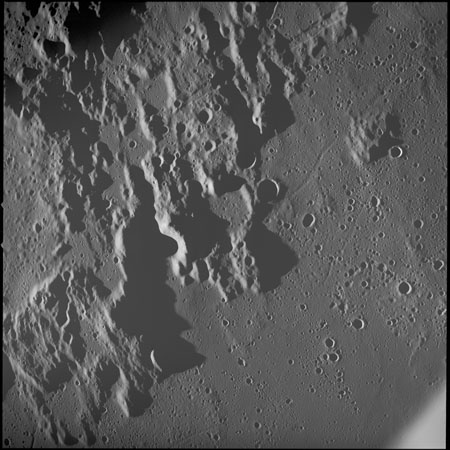
AS10-32-4781 - 80mm, showing an oblique view of Rhaeticus & Rhaeticus L - Image by NASA/JSC/ASU.
118:45:47 Lousma: 10, this is Houston. Let's actuate your High Gain and see if it's any better.
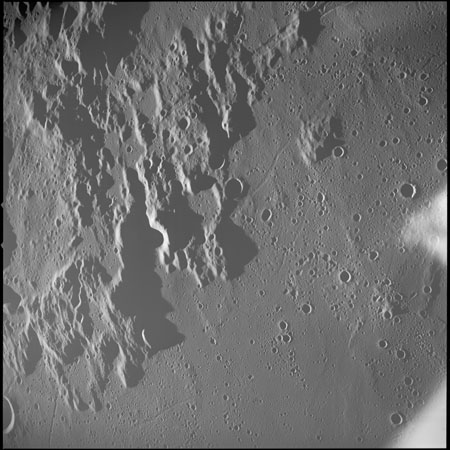
AS10-32-4782 - 80mm, showing an oblique view of Rhaeticus, Rhaeticus L & Sinus Medii - Image by NASA/JSC/ASU.
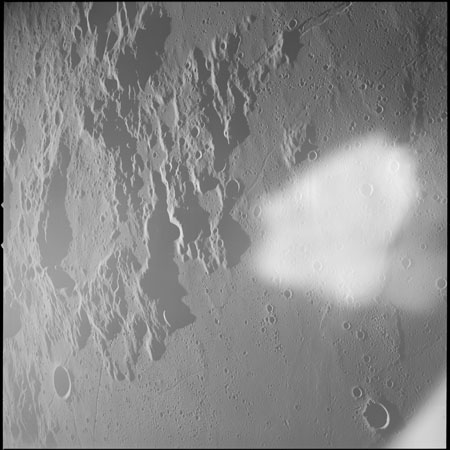
AS10-32-4783 - 80mm, showing an oblique view of Rhaeticus, Rhaeticus L & Sinus Medii - Image by NASA/JSC/ASU.
118:46:44 Lousma: Apollo 10, this is Houston. And could you continue on with your description of the Mylar insulation, please.
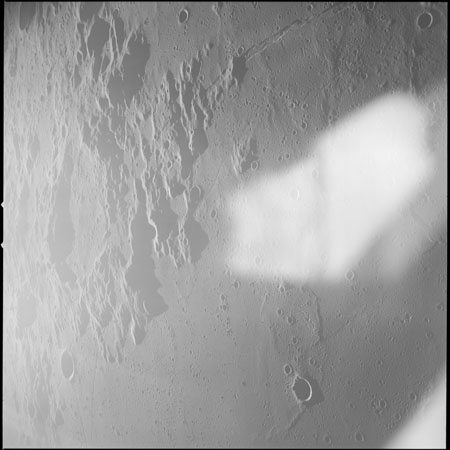
AS10-32-4784 - 80mm, showing an oblique view of Rhaeticus, Rhaeticus L, Sinus Medii & Blagg - Image by NASA/JSC/ASU.
118:46:53 Stafford: Right, Jack. I'm sure you remember from LM-3, and we had the same problem initially on LM-4, when we vented the same forward hatch in the altitude chamber, how all the Mylar blew out and it blew out the skin on the top side. Well, this is exactly what happened except we just had a few layers of Mylar and all this fiberglass insulation or something of that nature down below it, and when the Mylar - There just was no provisions made for really properly venting through the Mylar and when that blew out, that let all the insulation just flake out in the tunnel, and the probe and drogue were just packed in there with all this fluffy insulation. And so I'm not sure of the total design criteria for the new fix, but you sure want to fix it before the next Command Module flies because we've been itching and scratching in here for about 3 days. Over.
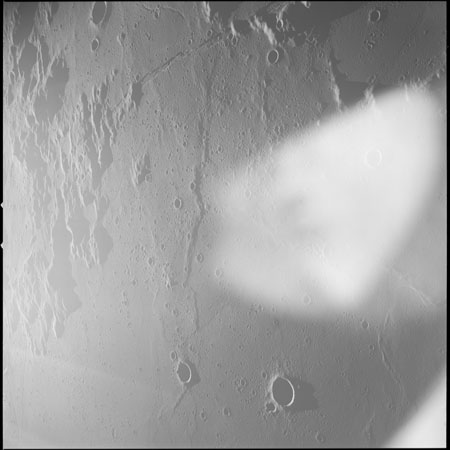
AS10-32-4785 - 80mm, showing an oblique view of Sinus Medii, Blagg & Bruce - Image by NASA/JSC/ASU.
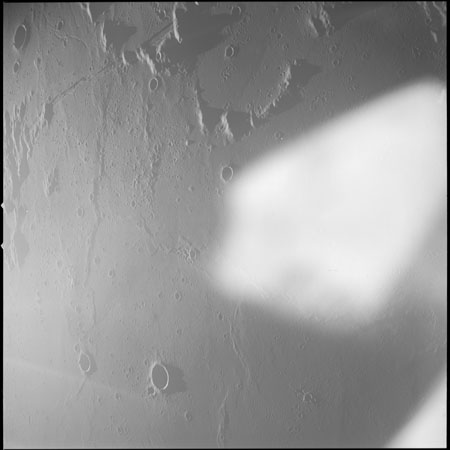
AS10-32-4786 - 80mm, showing an oblique view of Sinus Medii, Blagg & Bruce - Image by NASA/JSC/ASU.
118:47:42 Lousma: Roger. We copy, Tom. Have you noticed any formation of moisture up around the forward hatch?
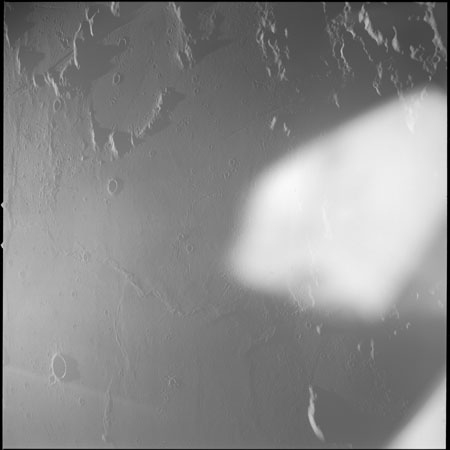
AS10-32-4787 - 80mm, showing an oblique view of Sinus Medii & Bruce - Image by NASA/JSC/ASU.
118:47:52 Young:That's affirmative. There are some beads of water up there right now.
118:47:57 Lousma: Roger, Copy. Beads of water. Thank you, John.
118:48:02 Young: And it's on the steel outer rim, which is that seat that sits against the seal. It's that outermost aluminum rim, and it's just covered with beads of moisture. For that matter, the whole tunnel walls were kind of moist, but it's nothing. It's nice and cool up there.
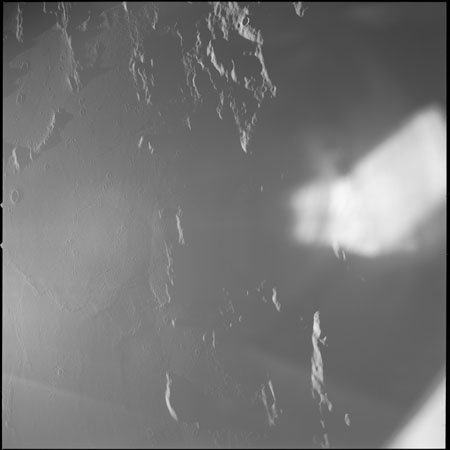
AS10-32-4788 - 80mm, showing an oblique view of western Sinus Medii - Image by NASA/JSC/ASU.
118:48:27 Lousma: Roger. That's another question we wanted to ask you, How was the cabin environment up there during the night? Was the temperature and humidity higher than before? Over.
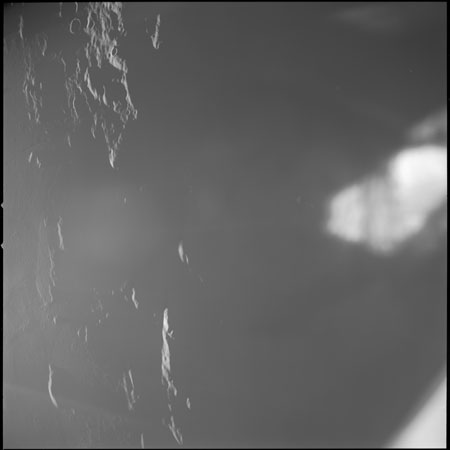
AS10-32-4789 - 80mm, showing an oblique view of western Sinus Medii - Image by NASA/JSC/ASU.
118:48:43 Young: It was great.
118:48:44 Stafford: The inside of the cockpit feels great. The only complaint is just all of the itching and scratching we had, due to the fiberglass. Over.
118:48:53 Lousma: Roger. Thank you.
118:49:00 Young: Jack, could we get a consumables update from you, a complete one?
118:49:08 Lousma: Roger. Consumables update follows: for GET of 117, RCS total 61; A, 51; Bravo, 70; Charlie, 62; Delta, 62; H
2 total 30.4; O
2 total 392; your RCS is 15 percent above the Flight Plan. Also have Flight Plan updates and we are ready for the state vector update when we can have your computer.
118:49:49 Stafford: Okay. We're in P00 and Accept. We are ready for the state vector.
118:49:53 Lousma: Roger. It's coming at you. I have a TEI PAD and a Flight Plan update for you.
118:50:03 Cernan: Go ahead with the update, then I will take the PAD, Jack.
118:50:10 Lousma: Roger. The Flight Plan update: way up the line, at 135 hours after LOS, we will have our waste water dump and all lunar activities are still about 12 minutes later than the preflight times, and that's the completion of the Flight Plan update.
118:50:39 Young: Waste water dump at 135 hours. Thank you.
118:51:01 Cernan: Okay, Jack. Go ahead with the PAD.
118:51:04 Lousma: Okay. I have a TEI number 23, maneuver PAD. SPS/G&N; 36818; minus 061, plus 076; 121:41:08.32; plus 29928, plus 3 balls 90, plus 01628; NA, pitch is 068; the rest is NA. Over.
118:52:07 Cernan: Okay. I've got TEI-23, SPS/G&N; 36818; minus 061, plus 076; 121:41:08.32; Noun 81 is plus 29928, plus 3 balls 90, plus 01628; roll is NA and pitch is 068; and the rest in NA.
118:52:31 Lousma: That's affirmative on that copy, and I have the vertical stereo PAD and a REV-23 update.
118:52:52 Cernan: Okay. Go ahead, Jack.
118:52:55 Lousma: Okay. Your map update PAD, REV-23: LOS, 119:21:26; 119:32:46; AOS, 120:07:36; sunrise, 119:34:44; sunset, 120:47:11. Over.
118:53:40 Cernan: Okay. REV-23: 119:21:26, 119:32:46, 120:07:36, 119:34:44, 120:47:11.
118:53:54 Lousma: Okay. And I have a vertical stereo PAD for you. T
0, 119:41:31; T
1, 120:10:58; T
2, 120:20:11; T
3, 120:30:18. And if you want to delay your roll at the sub solar point, you will be at 75 degrees east at 120:16:56. Over.
118:54:46 Cernan: Okay. Got T
0, 119:41:31; 120:10:58, 120:20:11, 120:30:18, 75 east at 120:16:56.
118:54:59 Lousma: That is affirmative and also would like to tell you something about your PU valve procedure. It's changed since the last one. The new procedure is this. Start with the PU valve in the Normal position for TEI, and after you bring in the second bank of ball valves, then go to Increase. The old procedures could cause a transient on startup. Over.
118:55:36 Cernan: Okay, Jack. I got it. Normal for start, we get 4 balls and go to Increase. And I guess we're all on now. If you want to pass us up that news you were going to do earlier, we're listening.
118:56:01 Lousma: Roger. I want to tell you also that you got the computer back. We're finished with the uplink. You can go to Block.
118:56:10 Cernan: We're in Block.
118:57:03 Lousma: Apollo 10, Houston. Before we go on with the news, we'd like to advise you that it's been decided that we will remove the insulation from the hatch of 107, and we tell you that so you just don't worry about not having much up there in yours and we also want to know if you're having problems inhaling or any problems breathing because of this insulation problem. Over.
118:57:32 Stafford: I figured that last question would come up as soon as we mentioned it. No. We've just been sneezing and coughing for 3 days and we understand what the problem is and how to take care of it. Over. We just wash them down and everything is Okay. It's just kind of irritating and itchy, Over.
118:57:49 Lousma: Roger. Sounds like living in the Dust Bowl in Oklahoma.
118:57:56 Stafford: Yes. I had some good training on that (laughter) area.
118:58:00 Young: That's right; he was right at home.
118:58:04 Stafford: It's not that way now. It's a beautiful place now, Jack.
118:58:40 Lousma: Okay, Apollo 10. You've got LOS and AOS. We are well caught up on information going up, so let's go up with the news now. Prague, Czechoslovakia: US astronaut Frank Borman, one of three lunar pioneers on the Apollo 8 Moon flight last year has been awarded the Czech Academy of Sciences Gold Medal for service to science and humanity. About 1,000 Czechs, shouting "Long live, glory, glory" greeted Borman, first American to win the award, as he stepped from the Academy building, Thursday. "By the end of 1970," Borman told the news conference, "we'll be able to take scientists and doctors of many nations on flights to the Moon." [Laughter.] New York: Johnny Carson was honored Thursday as the Performer of the Year by the International Radio and Television Society. Carson told the audience at the Americana Hotel that he was once chewed out by a station manager for oversleeping and missing a broadcast. "So I got cocky and told them that someday I would have my own network show and win an important award," Carson said. And the station manager said, "The day that happens, they'll send a man to the Moon." Hong Kong: Communist Chinese authority [laughter] - thought you'd get a chuckle out of that. Communist Chinese authorities have confiscated a Hong Kong fishermans permit because he played hookey from Mao Tse Tung's thought study classes. A Hong Kong government spokesman said today, "The licenses allowed him to operate in Hong Kong and Chinese waters." Washington: one of our old friends, Charles A. Lindbergh, the Lone Eagle of pioneer aviation, says rocket pioneer Robert Goddard told him in 1929 a Moon voyage was theoretically impossible, theoretically impos - correction - theoretically possible, but economically improbable. In a rare public utterance, the reporters and news photographers barred, Lindbergh philosophized about the future of American aviation, and reminisced about Goddard. He said Goddard told him it was possible to send a multistage rocket to the Moon; then he smiled a little bit and said, "It might cost a million dollars and of course that was out." [Laughter.] Carlton, England: Fred Alder, 67, saved all his life to buy an 11-bedroom house on the sea to give children from poor homes a vacation. "It's the happiest day of my life," Alder said, as the first contingent of 20 youngsters arrived at the house that cost him almost $20,000. He said 200 children will have 10 days at his new seaside home by the end of summer. And a trust fund has been set up for the future. Oh, yes, we heard again from that unemployed local philosopher. With all the excitement he lost his head and digressed from his favorite subject of color television to say that, "For three fellows who, by their own admission, could not figure out which way was up, you sure did a doggone respectable job yesterday." And here's the sports news. Houston beat Montreal 7 to 4. Atlanta beat New York 15 to 3. And the Cubs defeated Los Angeles last night 3 to 1. John Young has had these interesting astrocasts. Today it is, "Keep all operations above board. Confidential transactions are apt to blow up later with considerable embarrassment for all. Travel is better postponed; the people you would go to see are not yet set for the visit." [Laughter.] And in the golf world, at the Atlanta Classic, the first round leaders are George Knudson and Jackie Cupit, under par, 67. That's the news. Over.
119:02:44 Stafford: Roger. [Laughter.] Thank you very much, Jack.
119:02:51 Lousma: Oh, by the way, Tom, I've got your astrocast here too. "Your natural tendency for moderate, sparse consumption serves you well. Your system is a little more sensitive to strange foods."
119:03:06 Cernan: He's been eating like a horse for 4 days. He's the only one that saved us from the Mylar. He ate it up.
119:03:24 Lousma: Gene, I think we should read your astrocast here, too. Gene, "Conditions are bewildering. There are so many odd and unfamiliar details. Just curb your impatience; question everything, and put things into place, one at a time."
119:03:51 Lousma: Gene, this is Houston. I think you've got a pretty interesting forecast here, too. It says for you: "Conditions are bewildering. There are so many odd and unfamiliar details. Just curb your impatience; question everything, and put things into place, one at a time."
119:04:17 Cernan: Yes. That is interesting, isn't it?
119:04:20 Lousma: I guess so.
119:04:36 Cernan: Thank you, Jack.
119:05:02 Young: Just looking at that old world in the optics; sure looks nice.
119:05:59 Lousma: Apollo 10, Houston. We'd like to confirm that the ECS redundant component test is complete.
119:06:09 Cernan: No, Jack. It is not. We'll get it here immediately after the P52.
119:06:13 Lousma: Roger. We're standing by.
119:06:14 Cernan: I'll start on the secondary boilers right now. Okay, I'll start on the secondary boilers right now.
This is Apollo Control, a little over 12 minutes remaining until Loss Of Signal on this 22nd lunar revolution. Continuing to monitor air-ground for any further conversation.
119:10:20 Lousma: Apollo 10, Houston. When you have time we'd like to have some discussion regarding three questions about yesterday's activities. Over.
119:12:26 Stafford: Hello, Houston. Apollo 10.
119:12:29 Lousma: Roger. Go ahead, 10.
119:12:32 Stafford: Okay. I talked to Jack Schmitt a time before the flight and on this pass if youd like to correlate it after I roll to 180 degrees there, and you can do that around the sub solar point or before. If you've got Goldstone in configuration, we can shoot you the tube for the vertical pass all the way down and maybe even shoot the solar corona at the end. Over.
119:13:04 Lousma: Roger. Stand by.
119:14:18 Lousma: Apollo 10, Houston. In order to have TV without compromising photography and so forth, you'll have High Gain acquisition when you come AOS, but you should do your roll maneuver before 65 degrees east. Over.
119:14:47 Stafford: Roger. Roll before 65 east. When are you going to correlate that time? Over.
119:14:52 Lousma: Okay. We've already given you that on the vertical stereo PAD. It's your T
2 time of 120:20:11; that's 65 east.
119:15:06 Stafford: Okay. And we'll have good High Gain lock after that, Right?
119:15:16 Lousma: After 65 east, you'll lose it. Over.
119:15:23 Stafford: Roger. After 65 east we will lose it. Yes. It's hardly worthwhile then to - We'll only be there for a few minutes. We'll hold off.
119:15:35 Lousma: Roger. Copy holding off.
119:16:01 Lousma: Apollo 10, Houston. We're unable to copy your P52 torquing angles. We'd like you to read them down. Over.
119:16:17 Young: Would you believe we didn't copy them down? We figured you were reading them. I seem to recall a 3 and a 6, three-tenths of a degree or something like that.
119:16:38 Lousma: Roger. Thanks.
119:16:45 Young: I realize that's not what you're looking for, but it wasn't bad.
119:16:53 Lousma: Roger. We copy, John.
119:17:22 Young: Okay, Houston. We're doing the main regulator checks now.
119:17:26 Lousma: Roger. Copy.
119:19:33 Lousma: Apollo 10, Houston. We think the unscheduled tube action would best come around Rev-29, and we have a question about the LM acquisition lights after staging. Did John see the LM ACQ lights any time after staging? Over.
119:20:17 Stafford: Houston. Apollo 10. Talking about the big track light out there above the forward hatch. John saw it all the way, in fact, we had to turn it off for him at the end it was so bright. Over.
119:20:22 Young (onboard): [Garble]. Beautiful. It fills up the whole reticle when it's close - close in, about 10 or 11 miles [18 or 20 km].
119:20:25 Cernan (onboard): Yes, I could see it out to - Shoot, there one time, it was over 200 miles [370 km].
119:20:26 Lousma: Roger. Copy you saw it all the way.
119:20:46 Stafford (onboard): Could you see us all the way out there? Because that was over 300 [miles, 555 km] [garble].
119:20:49 Lousma: And, Apollo 10, Houston. Do you have any idea what might have fixed the VHF problem after undocking yesterday?
119:20:52 Young (onboard): Yes. Yes. While I wasn't tracking [garble] No idea whatsoever. We just tried it again and it worked.
119:21:06 Stafford: Yes. We had the same switch configuration again that was - thought it might be corona but, I mean, there was no way for us to tell, but you did come in just unreadable before and after we undocked and squared away. We tried again and it was unreadable and we tried it one more time...
Stafford (onboard): ....and it was beautiful. And he had VHF Ranging out to more than...
Stafford: ....200 miles.
119:21:21 Lousma: Roger, 10. See you around the corner.
119:21:50 Young (onboard): [Garble] ain't going to bother him [garble].
119:21:55 Stafford (onboard): [Laughter.]
119:21:56 Young (onboard): What did I say?
119:21:57 Stafford (onboard): No sunlight on us now. That's what we [garble] Got 20 minutes to [garble] again.
This is Apollo Control. We have had Loss Of Signal as Apollo 10 went around the corner, the back side of the Moon on revolution 22. Next acquisition; 120 hours, 7 minutes Ground Elapsed Time, revolution 23. During that pass, after the crew had completed the oblique strip stereo photography over Landing Site 2, they were read up a consumables update from the ground. Flight Plan update with one minor addition further on in the mission. They were given the revolution 23 TEI PAD. which would be just a contingency batch of numbers to use for ignition of Trans-Earth Injection burn if it became necessary. They were also given times for vertical stereo strip photography coming up this next revolution; the terminator to terminator strip photography taken with the camera pointing vertically to the lunar surface beginning at 65 - running between 65 east longitude and 34 degrees east longitude, pointing the camera somewhat north of the track to include Landing Site 1. Some 44 minutes it looks like until next acquisition. That must be an error apparently the clock has not been set after this last LOS. And at 119 hours - now we're getting a new time for next acquisition; 120 hours, 7 minutes through Madrid for next Acquisition Of Signal. And at 119 hours, 24 minutes Ground Elapsed Time; this is Apollo Control.
119:22:37 Young (onboard): Okay, Houston, I did a sextant star check just to make sure that was a good alignment. The star's pretty close to being in the middle of the scope.
119:23:28 Young (onboard): Hey, lookie here. Them [garble] finally figured out a way to [garble]. How about that?
119:23:38 Young (onboard): I'm trying to. I can't find it. I don't know where it is - [garble] and say, well, there's [garble] Mars and all that shit. [Garble], babe. It looks to me like it's shit. We going [garble] today?
119:24:09 Stafford (onboard): Yes. Thought we'd [garble].
119:24:46 Young (onboard): Boy, I bet you that low light level [garble].
119:24:53 Stafford (onboard): Hello. Houston; Apollo 10.
119:25:22 Stafford (onboard): Gene-o. When we do this landmark tracking, it's going to be a beautiful time to get the Earth coming up.
119:25:29 Cernan (onboard): You're right.
119:25:32 Stafford (onboard): After we [garble].
119:25:36 Young (onboard): I got to [garble].
119:25:39 Stafford (onboard): Yes. Yes. Fine, [garble].
119:25:43 Cernan (onboard): [Garble].
119:25:46 Stafford (onboard): Yes. We ought to get that film stuff all - I got a bunch back here that I got before [garble].
119:25:57 Cernan (onboard): [Garble].
119:25:58 Stafford (onboard): You got - Here's one color, Gene-o. Color was all used up. Now we have special color back here, I think.
119:26:10 Young (onboard): And I got black and white.
119:26:14 Stafford (onboard): I got the special color...
119:26:15 Cernan (onboard): [Garble].
119:26:19 Stafford (onboard): The only other roll we had is that one in the LM.
119:26:22 Cernan (onboard): Is it?
119:26:23 Stafford (onboard): Yes. Now where is that one at? Is that that one? You what?
119:26:28 Cernan (onboard): [Garble].
119:26:30 Young (onboard): Where does this go? Where does this go?
119:26:33 Stafford (onboard): You had two rolls...
119:26:34 Young (onboard): Where does this go?
119:26:35 Stafford (onboard): ...you had one in the Command Module, one in the LM, and one [garble] special. Now, the main thing is, where is that roll of color film?
119:26:46 Stafford (onboard): How about getting me one roll of color film? You may need a different dark slide on it. That dark slide is all freaked up, too. We start this pass in 15 minutes, Gene-o.
119:27:07 Stafford (onboard): The vertical path.
119:27:09 Cernan (onboard): [Garble].
119:27:11 Stafford (onboard): That's just after - [garble] vertical path. Okay? It's just that - it's just [garble]. Yes. When you don't take any oblique, you don't pitch over.
119:27:28 Stafford (onboard): No. Just the - just the - We don't need the sequence [garble]. How much color film do we have left? Have you got all the exposed and unexposed? We ought to take inventory. We ought to get some good stuff of that Moon [means Earth] coming up.
119:27:46 Young (onboard): We don't have any more color film?
119:27:50 Cernan (onboard): I can't believe [garble].
119:27:54 Stafford (onboard): That's it. That's why I was anxious to get [garble].
119:28:03 Young (onboard): Hell, they had too many goddam [garble].
119:28:10 Stafford (onboard): Should I call up Verb 82, José?
119:28:13 Young (onboard): Yes.
119:29:08 Stafford (onboard):That noise on that VHF sure sounded weird yesterday, didn't it?
119:29:10 Young (onboard): Yes, it did.
119:29:18 Stafford (onboard): Okay. Now when we first start - near the terminator we're going back to what they gave us on this card, f:4 and 250 [garble] As it gets lighter, we'll go to f:4 at [garble].
119:30:33 Stafford (onboard): That works out pretty good. I tried to extrapolate ahead for you when I got that attitude [garble].
119:31:20 Stafford (onboard): 65 east, I yaw right.
119:31:26 Young (onboard): [Garble] go right [garble].
119:31:44 Young (onboard): (Sneeze) Pardon me. Gene-o, could you give me a tissue?
119:31:54 Young (onboard): Yes. Just give me one of them.
119:32:00 Stafford (onboard): John, [garble] paper is all over.
119:32:57 Stafford (onboard): [Garble], you know it, you know it [garble].
